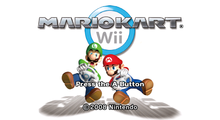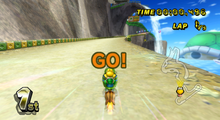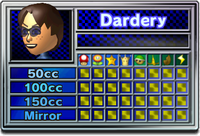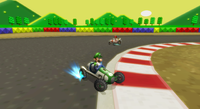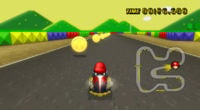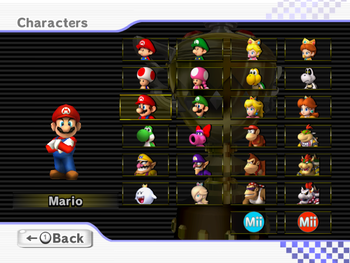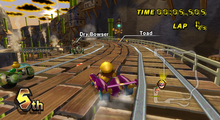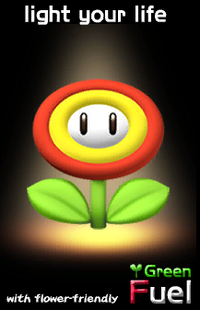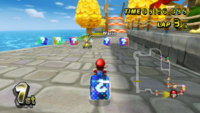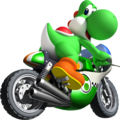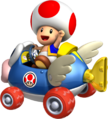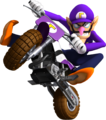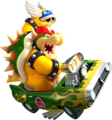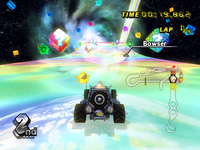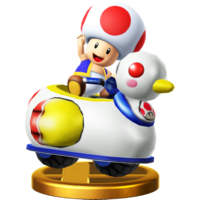Mario Kart Wii
| Mario Kart Wii | |||||||||||||||||
|---|---|---|---|---|---|---|---|---|---|---|---|---|---|---|---|---|---|
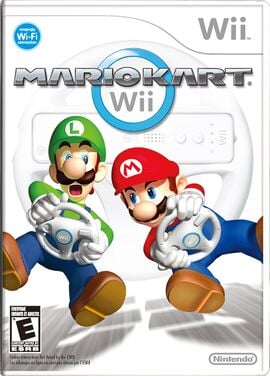 United States box art 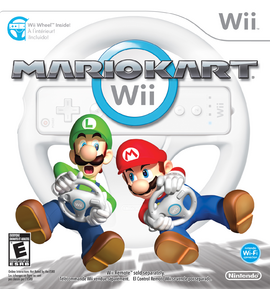 Wii Wheel bundle box For alternate box art, see the related gallery. | |||||||||||||||||
| Developer | Nintendo EAD | ||||||||||||||||
| Publisher | Nintendo | ||||||||||||||||
| Platform | Wii | ||||||||||||||||
| Release dates | Wii (original release): Wii (Nintendo Selects): | ||||||||||||||||
| Languages | English (United States) English (United Kingdom) Japanese French (Canada) French (France) German Italian Korean Spanish (Latin America) Spanish (Spain) | ||||||||||||||||
| Genre | Racing | ||||||||||||||||
| Ratings |
| ||||||||||||||||
| Modes | Single player, multiplayer, online play | ||||||||||||||||
| Format | Wii: | ||||||||||||||||
| Input | Wii:
| ||||||||||||||||
| Serial code | |||||||||||||||||
Mario Kart Wii is a multiplayer-oriented racing game from the Mario Kart series for the Wii, developed by Nintendo EAD. Mario Kart Wii retains the traditional premise of the franchise, with players selecting Super Mario–franchise characters to use as drivers alongside themed vehicles. As with most racing games, the overarching goal is to place first among other competitors, achieved through the usage of item-based weaponry common to the series and taking the fastest routes to secure the lead. Several new key elements introduced to Mario Kart Wii include increasing the number of racers per race from eight to 12, tricks, and a new type of vehicle to the franchise: bikes. The game takes advantage of features unique to the Wii, most particularly its motion control capabilities. A Wii Wheel was included in most releases, though the game is still compatible with other controllers such as a regular Wii Remote held sideways, the Wii Remote and Nunchuk, the Nintendo GameCube controller, and the Classic Controller and Classic Controller Pro. Additional game modes are also present, such as the traditional Grand Prix, Versus, Battle, and Time Trial modes.
This game requires 23 blocks of storage on the player's Wii system to save game data. The game's data cannot be copied onto another Wii, making this the only game in the Mario Kart series where data cannot be transferred between consoles. The game also includes its own Wii Channel, called the Mario Kart Channel, which allows players to play in special tournaments and trade their racing profile with other players around the world. This channel uses 74 to 88 blocks (depending on the game's region), but unlike with the game data, players can copy the channel onto their SD cards.
With over 37 million copies of the game sold, Mario Kart Wii is the second-best-selling Wii game and Mario Kart game (after Wii Sports and Mario Kart 8 Deluxe, respectively) and the best-selling Super Mario game for the Wii console.[6]
The game supported Nintendo Wi-Fi Connection for online multiplayer play until the service was terminated by Nintendo on May 20, 2014.
Gameplay
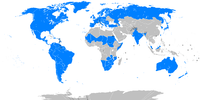
Mario Kart Wii retains most of the elements from previous Mario Kart games, especially Mario Kart DS. Players select a racer from a cast of Super Mario characters, who are all divided into size categories in relation to their stats, and they need to select a vehicle from the class they belong in, all with their own stats. All races start with players at a line corresponding to their proper position, where Lakitu signals the countdown time. Once the time is finished, players race three laps around a race course in an attempt to be first of the pack. Once the third lap is completed, players are ranked points depending on how well they placed in the race. While every previous Mario Kart game allowed for a maximum of eight racers on each course, up to twelve are on the course at a time in Mario Kart Wii. In Grand Prix and VS mode, player characters always start out on the latter positions; once they finish the race, their position is saved as they move on to the next race. Like Mario Kart: Super Circuit and Mario Kart DS, Mario Kart Wii shows a rating of how well a player performed after the trophy presentation: ★★★, ★★, ★, A, B, C, D, and E (E being the lowest ranking and ★★★ being the highest).
Integral to the Mario Kart series is the usage of Super Mario-themed items to use as weapons against other racers in the track, either directly benefiting the player or hurting another player's progress. Players can receive these items at random from Item Boxes scattered around the track. The quality of the item received depends on the position of the racer: racers who are further down the line receive stronger items to help compensate their poorer performances. For examples, lower racers receive Mushrooms as speed boosts, Stars for faster invincibility, etc. while higher-placed racers receive weak items such as Green Shells and Banana Peels. When players receive an item, they can stop the item roulette faster by pressing the corresponding item button.
Several advanced techniques are retained in Mario Kart Wii from prior Mario Kart titles, although several tweaks have been made to them. Players can drift through tougher curves to maintain speed; players can perform a Mini-Turbo when players receive color-coded sparks from drifting, which depends on how long players can hold the button for drifting and the angle at which they drift. Introduced in Mario Kart Wii are two drift modes: Automatic and Manual. Automatic drifting allows players to automatically drift when turning very sharply, though players cannot perform Mini-Turbos regardless of how well they drift. Manual mode requires players hold down a button to drift, but releasing the button may release a Mini-Turbo, the strength of it depending on the color of the sparks. Players are now able to perform tricks when they driver over specific types of ramps. When drivers perform a trick and land successfully, they gain a momentary boost of speed. Tricks consist of mid-air acrobatics and are performed by shaking the Wii Wheel upward, shaking the Wii Remote in the Wii Remote + Nunchuk combo, pressing the ![]() on the Classic Controller, or pressing the
on the Classic Controller, or pressing the ![]() on the GameCube controller.
on the GameCube controller.
Motorbikes are introduced in this game, alongside having a wider variety of karts to select from. Motorbikes can perform wheelies to increase top speed on straights, though motorbikes cannot perform the most powerful Mini-Turbo that karts can. Motorbikes also come in two classes: drift type and hang-on type. Drift type bikes drift in a similar way to karts, while hang-on type bikes commit to the turn instead.
Prior to discontinuation of online services, Mario Kart Wii featured a text chat in Online Multiplayer Mode when racing or battling against Friends. Users could send pre-written phrases to other users before the series of races started. However, there was no facility for a user to type custom messages.[8]
Another new change is the point system used for Grand Prix races. With twelve racers competing in each race, the point value has increased from 10/8/6/4/3/2/1/0 points for first to eighth place respectively to 15/12/10/8/7/6/5/4/3/2/1/0 points for first to twelfth place respectively. Also, 4th and 5th place are not losing positions. The following chart shows the difference of the point spreads from previous games to this installment.
| Point Spread Comparisons (GP) | ||||||||||||
|---|---|---|---|---|---|---|---|---|---|---|---|---|
| 1st | 2nd | 3rd | 4th | 5th | 6th | 7th | 8th | 9th | 10th | 11th | 12th | |
| Super Mario Kart Mario Kart 64 Mario Kart: Super Circuit |
9 | 6 | 3 | 1 | 0 | 0 | 0 | 0 | — | — | — | — |
| Mario Kart: Double Dash!! Mario Kart DS |
10 | 8 | 6 | 4 | 3 | 2 | 1 | 0 | — | — | — | — |
| Mario Kart Wii | 15 | 12 | 10 | 8 | 7 | 6 | 5 | 4 | 3 | 2 | 1 | 0 |
| Grove-green bg signifies victory results (great clapping, character(s) cheering), best after-race music Yellow-limegreen bg signifies moderate results (mild clapping, moderate character reaction), same music in Wi-Fi as winner (different in MKDS GP) Normal bg signifies losing results, losing music; - means not available In Super Mario Kart, and Mario Kart Super Circuit, 5th or worse forces the player to retry the race. If the racer fares this badly four times, the Grand Prix must be started over. In Mario Kart 64, 5th or worse forces the player to retry the race, but without the restrictions on how many times the player can retry a race. In Mario Kart: Double Dash and other installments after that game including this installment, the Grand Prix normally goes forth. | ||||||||||||
Controls
Mario Kart Wii takes advantage of the Wii Remote's motion-sensing ability. By tilting the remote, players can steer their karts. Since the Wii Remote is designed to be inserted into the Wii Wheel for better grip, players can also play without the Wheel if they choose to. Mario Kart Wii can also be played by connecting the Nunchuk Controller or the Classic Controller, or using the GameCube Controller. Controlling the vehicle is divided up into two sections: Basic and Advanced.
| Action(s) | ||||
|---|---|---|---|---|
| Wii Remote (Wii Wheel) |
Wii Remote + Nunchuck |
Wii Classic Controller | GameCube Controller | |
| Steer | Tilt |
|||
| Accelerate / Rocket Start | ||||
| Brake / Drift / Reverse | ||||
| Use Item | ||||
| Trick | Shake |
Shake |
||
| Wheelie | Flick |
Flick |
||
| Stop Wheelie | Flick |
Flick |
||
| Rear View |
Basic controls and actions
- Accelerate: When drivers hold down the corresponding button, the vehicle goes forward. Accelerating time depends on the type of karts: Lightweight karts have a high acceleration but low speed. Heavyweight karts tend to have a low acceleration but a high top speed. Middleweight karts tend to have an average top speed and acceleration.
- Steer: Steering lets drivers move around corners.
- Brake: Braking slows the vehicle to an abrupt stop.
- Reverse: The driver's kart goes backwards if the driver continues holding the brake button after the vehicle comes to a stop. If a vehicle reaches maximum top speed, the vehicle will drift instead. If the player tries to accelerate while going in reverse, the vehicle will start to build momentum. When blue sparks start to appear, the player can release the brakes to get a small speed of boost.
- Look Behind: Drivers can look behind their vehicles. In this way, drivers can be alert from other drivers incoming to steal their place. Drivers can also use this feature to see where they are going while backing up, or to aim a weapon at an opponent following up. This feature once appeared in Super Mario Kart.
- Drift: Drivers drift to keep the vehicle's speed and take corners more easily, with the benefit of getting Mini-Turbos. The feature can be set to happen automatically or when a button is held, although Mini-Turbos cannot be obtained on the former setting.
Advanced control modes
- Rocket Start: Drivers can perform a speed boost when a race begins. If drivers hold down the corresponding acceleration button right after the countdown timer displays the number 2, then they will receive an extra speed boost when the word "GO!" appears on the screen. However, if drivers hold down the button for too long, when the final beep is heard, their engine bursts and they get an even worse start than a regular one and take a few seconds to recover.
- Mini-Turbo: When drivers drift for a reasonable amount of time varying on the vehicle used, blue sparks erupt from the vehicle's rear tires. Releasing the drift button gives them a short burst of speed. In a kart, drivers can keep drifting for longer periods to get orange sparks and a longer boost. However, orange sparks cannot be created on bikes. The amount of time the player must drift also depends on the vehicle's drifting stats. Drivers can also perform a "standing Mini-Turbo" by holding the brake/drift and acceleration buttons at the same time. This is helpful for vehicles with slow acceleration, as it will get the vehicle to top speed. A Mini-Turbo cannot be performed when drifting is set to automatic, but the standing Mini-Turbo can.
- Jumps: If players jump over ramps or mushrooms, the length of the jump can be controlled by
 (shorter jump) and
(shorter jump) and  (longer jump).
(longer jump). - Tricks: Drivers can pull off a trick when they jump in order to gain a momentary Mini-Turbo. Drivers can perform a trick by flicking the Wii Remote, pressing
 on the Classic Controller, or pressing
on the Classic Controller, or pressing  on the GameCube Controller in any direction when going off a ramp or hill. They obtain a speed boost when landing.
on the GameCube Controller in any direction when going off a ramp or hill. They obtain a speed boost when landing. - Wheelie: Wheelies can be performed only when drivers are riding bikes. Drivers can increase their speed by lifting up the fronts of their bikes. While drivers perform a wheelie, the bike cannot be easily steered. The wheelie can be ended by braking, hopping, waiting for the wheelie to end, or simply setting the Wii Wheel or Wii Remote back down or pressing
 . If drivers are bumped into while they are performing a wheelie, they lose most of their speed. If they wheelie again right as their wheelie runs out, they can get a chain wheelie.
. If drivers are bumped into while they are performing a wheelie, they lose most of their speed. If they wheelie again right as their wheelie runs out, they can get a chain wheelie. - Bullet Bill: If a driver is flying as a Bullet Bill, its route can be controlled a bit with
 and
and  . The range may differ for every part of a track.
. The range may differ for every part of a track.
Licenses
Licenses replace normal save files. It is the first Mario Kart game to feature more than one save file.
Each license contains each player's data, their Mii, nickname, Friend Code, and a table including all categories and cups with an empty space. After a cup is won, the corresponding space is filled in with a colored square: gold for first place, silver for second, bronze for third. If at any time the Mii being used for Mario Kart Wii is deleted from the Mii Channel, the in-game Mii is also deleted.
Friend roster
Players can add different people around the world on to their Mario Kart Wii Friend Roster. Two people need to add the Friend Codes on their licenses. A player can have up to 30 people on their Friend Roster.
If two people are friends on a roster, one can open a room, which allows who is ever friends with the person to join that room. In the room, the players who joined can send messages. If a player who added the person who created the room, and another person joins and the player has not added them, they have an ability to do so. The host of the room can choose a VS Race, Team VS Race, Balloon Battle, and Coin Runners.
If a player joins a race when another player is online and friends with them, the player who added the player in the race can join that race and race with the friend.
Game Modes
In Mario Kart Wii, both normal races and battles were playable online through the use of Nintendo Wi-Fi Connection (WFC). This was the second game in the series to utilize the WFC, the third to support online connectivity, and the first to allow for online battles. Races and Battles would now cater up to 12 players via Wi-Fi connection.
Grand Prix
A singleplayer mode where the player races against eleven CPU-controlled opponents to finish in first. There are eight cups to choose from, ranging from the least to the most difficult. Drivers earn points by placing within twelve positions (see chart above). A driver with the most points at the end of the four races wins the cup. The driver will be awarded a grade for their racing performance at the end of the cup. If the character places 4th or under, the screen will say "Better Luck Next Time" as the character sits in their vehicle on a mountain far from the celebration. Grand Prix Mode initially allows only Karts in 50cc and only Bikes in 100cc; if all the Grand Prix's are won in a single engine class, the other vehicle type will become available for it. Mirror Mode is unlocked by scoring first place on all 150cc Grand Prix.
Just like in Mario Kart DS, it is not possible to play Grand Prix with multiple players. Players can now only win cup trophies by playing alone.
Time Trial
A singleplayer mode where the player races for the fastest time on a selected course. The fastest record is saved as a Ghost and can be raced against at a later time. Drivers can also race staff records, Regional Records/Champions, World Records/Champions (Wi-Fi must be used), and Friend Records (Friend must be registered and must send the Ghost for Ghost Races, and Wi-Fi also must be used.)
VS Race
Playble with 1 to 4 players locally, and up to 12 online. Drivers can race with their own custom settings, but it is otherwise relatively the same as Grand Prix, other than the fact that drivers can see the other racers' character's names. The driver may choose a Solo Race, where they try to win for themselves, or Team Race, where two teams, red and blue, try to win by gathering the most points and beating the other.
Battle
Playble with 1 to 4 players locally, and up to 12 online. Drivers team up in two teams of six in a battle for the most points within a 3 minute time limit. Items work only against the opposite team and have no effect on the team that uses them. Players can select only the Standard Kart or Bike, color-coded for the team they are on. There are two ways to battle:
- Balloon Battle: All drivers get three balloons and must use the items to hit the opponents to pop their balloons and get one point for every hit. If drivers lose all their balloons, one point is deducted and Lakitu brings them back to the battle with three balloons once more. If the player uses a mushroom and bumps into a player on the other team with the boost, or hits them with a star, they get a point and steal a balloon.
- Coin Runners: The goal for drivers is to obtain more coins with their team than the other. In the top right corner of the screen, the score shows, which are the coins obtained altogether for each team. If drivers hit opponents, opponents drop their Coins. The number of Coins dropped depends on the item that hits the player and the number of coins that the player has already gathered.
The Spiny Shell makes its first appearance in Battle Mode in this game, chasing the player of the opposite team with the most points.
Ghost Race
A singleplayer mode played in the Mario Kart Channel. A Time Trial with Ghosts made by players around the world with relatively the same skill level to the actual player.
Tournaments
- Main article: List of Mario Kart Wii tournaments
Mario Kart Wii introduces a new mode for the Mario Kart series, entitled "Tournaments" (known as "Competitions" in the European version). This mode served as the replacement of Mission Mode from Mario Kart DS. New tournaments were posted twice a month and can be played on the Mario Kart Channel, as long as the Mario Kart Wii disc is in the Wii. Tournaments require an Internet connection and WiiConnect24 to be turned on before they can be played. After a while, a tournament is retired to make room for a new one. However, the rankings of older tournaments can still be viewed on the rankings table. The tournaments began in May 2008 and continued even after all WiiConnect24 services were discontinued on June 28, 2013. The tournament service itself was later discontinued on May 10, 2014, 10 days before the Nintendo WFC servers shut down.
The varieties of tournaments include the following:
- VS Race - A standard VS race; however, race courses were somewhat altered.
- Time Trial - A standard Time Trial; however, race courses were somewhat altered.
- Numbered Gates - The player had to drive through ordered gates as fast as possible.
- Coin Collecting - The player had to collect the coins on the stage as fast as possible.
- Boss Battle - The player had to fight against a special boss.
Characters
Mario Kart Wii features 12 starting characters, while 14 (if both Mii outfits are counted as separate characters) more can be unlocked for a total of 26 playable characters. Of those characters, Baby Peach, Baby Daisy, Rosalina, Funky Kong, Dry Bowser, and Mii (in "Outfit A" and "Outfit B") are playable for the first time in the Mario Kart series, with Baby Daisy, Rosalina, and Dry Bowser making their first playable appearances overall, and Baby Daisy making her first appearance in any game. In addition, Dry Bones is playable in a home console Mario Kart installment for the first time, after previously being playable in Mario Kart DS. Unlike with the past Mario Kart titles, however, the characters are categorized under a size class system, instead of the usual weight class system.
The size classes are as follows:
- Small: Small drivers will drive small vehicles. They usually have good acceleration, handling, and off-road stats, but low top speed and weight.
- Medium: Medium drivers will drive medium-sized vehicles. Most of the karts show average weight and off-road.
- Large: Large drivers will drive large vehicles. They mostly feature high top speed and weight, but low acceleration, handling, and off-road.
Additionally, all the characters in the game have their own set of bonuses that boost certain stats for their vehicles. Units are out of 80, so a stat bonus of 3 would make a stat three points better than normal.[9] Baby Peach and Large Miis have the most stat bonuses, with a total of 15 each. Bowser Jr. has the fewest stat bonuses, with a total of 6. Discounting Miis (which are not selected by CPU racers and do not have a defined weight class), this is the second consecutive game where the player classes are divided evenly, with eight characters in each.
Default drivers
| Driver | Size | Bonuses |
|---|---|---|
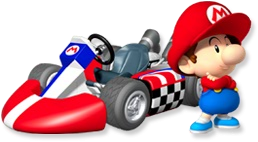 Baby Mario |
Small | Weight +8 Handling +6 |
 Baby Peach(new) |
Small | Speed +3 Weight +6 Acceleration +3 Handling +3 |
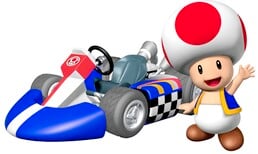 Toad |
Small | Acceleration +6 Drift +6 |
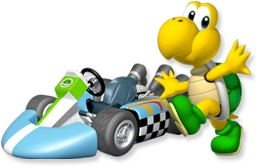 Koopa Troopa |
Small | Handling +3 Mini-Turbo +6 |
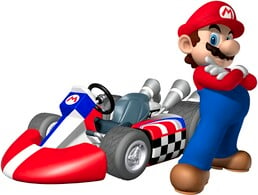 Mario |
Medium | Weight +6 Acceleration +2 Handling +2 Drift +3 |
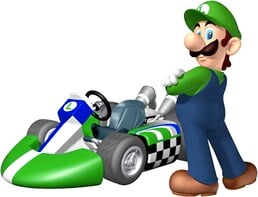 Luigi |
Medium | Speed +2 Weight +6 |
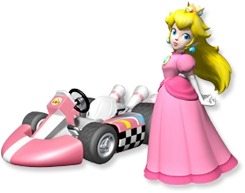 Peach |
Medium | Speed +2 Acceleration +5 Drift +6 |
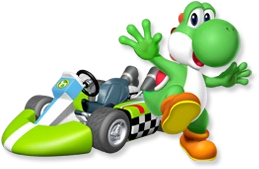 Yoshi |
Medium | Weight +3 Drift +3 Off-Road +5 |
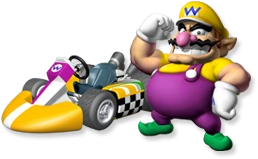 Wario |
Large | Weight +3 Off-Road +3 Mini-Turbo +6 |
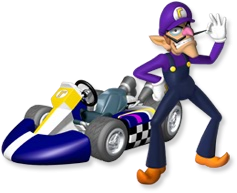 Waluigi |
Large | Acceleration +6 Drift +5 Off-Road +3 |
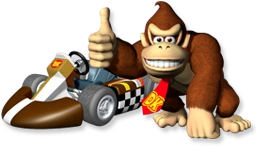 Donkey Kong |
Large | Weight +3 Acceleration +2 Handling +2 Mini-Turbo +3 |
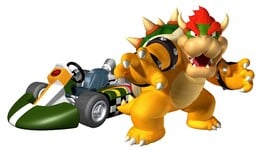 Bowser |
Large | Speed +2 Weight +5 Drift +3 |
Unlockable drivers
| Driver | Size | Bonuses | Unlock methods | ||
|---|---|---|---|---|---|
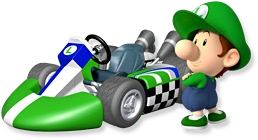 Baby Luigi |
Small | Speed +5 Weight +8 |
Unlock 8 Expert Staff Ghost Data records in Time Trials / Play 3,150 races / Win 100 WFC Ghost races | ||
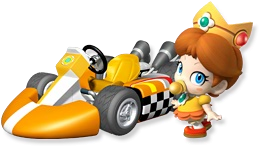 Baby Daisy(new) |
Small | Speed +5 Weight +6 Mini-Turbo +3 |
Rank 1 Star or higher in all 50cc Wii Grand Prix Cups / Play 1,950 races | ||
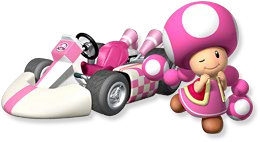 Toadette |
Small | Speed +3 Off-Road +6 |
Play Time Trials on all courses / Play 2,550 races / Win 1,000 WFC races | ||
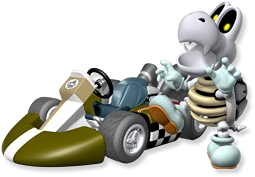 Dry Bones |
Small | Acceleration +3 Drift +3 Mini-Turbo +6 |
Win the 100cc Leaf Cup / Play 1,050 races | ||
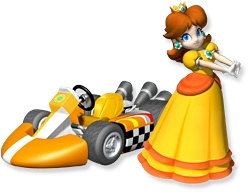 Daisy |
Medium | Speed +4 Handling +2 Mini-Turbo +3 |
Win the 150cc Special Cup / Play 2,850 races | ||
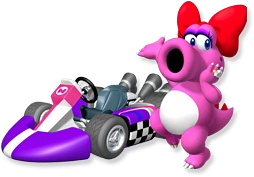 Birdo |
Medium | Weight +3 Off-Road +3 Mini-Turbo +5 |
Play Time Trials on 16 different courses / Play 1,350 races / Win 250 WFC races | ||
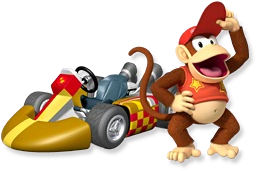 Diddy Kong |
Medium | Acceleration +3 Drift +3 Mini-Turbo +5 |
Win the 50cc Lightning Cup / Play 450 races | ||
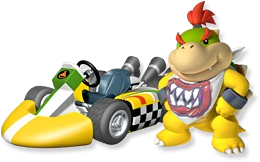 Bowser Jr. |
Medium | Off-Road +3 Mini-Turbo +3 |
Rank 1 Star or higher in all 100cc Retro Grand Prix Cups / Play 3,450 races | ||
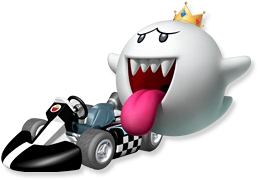 King Boo |
Large | Handling +5 Off-Road +3 |
Win the 50cc Star Cup / Play 750 races | ||
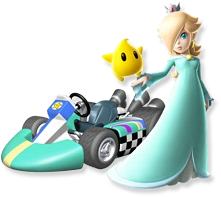 Rosalina(new) |
Large | Speed +3 Handling +3 Mini-Turbo +3 |
Rank 1 Star or higher in all Mirror Cups / Play 4,950 races / Play 50 races with a Super Mario Galaxy save file | ||
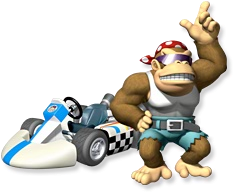 Funky Kong(new) |
Large | Speed +4 Off-Road +3 |
Unlock 4 Expert Staff Ghost Data records in Time Trials / Play 2,250 races / Win 25 WFC Ghost races | ||
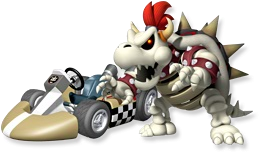 Dry Bowser(new) |
Large | Off-Road +6 Mini-Turbo +6 |
Rank 1 Star or higher in all 150cc Wii Grand Prix Cups / Play 4,350 races | ||
Mii Outfit A(new) |
Height-and-width dependent | Small: Speed +3 Weight +3 Drift +3 Mini-Turbo +3 |
Medium: Speed +3 Weight +3 Off-Road +3 Mini-Turbo +3 |
Large: Speed +3 Acceleration +3 Handling +3 Off-Road +3 Mini-Turbo +3 |
Win the 100cc Special Cup / Play 1,650 races |
Mii Outfit B(new) |
Height-and-width dependent | Small: Speed +3 Weight +3 Drift +3 Mini-Turbo +3 |
Medium: Speed +3 Weight +3 Off-Road +3 Mini-Turbo +3 |
Large: Speed +3 Acceleration +3 Handling +3 Off-Road +3 Mini-Turbo +3 |
Unlock all 32 Expert Staff Ghost Data records in Time Trials / Play 5,100 races / Win 5,000 WFC Ghost races |
Vehicles
There are thirty-six total vehicles in this game. There are 18 karts, 18 bikes, each divided into the 3 size classes, making 6 and 6 available to each character, 3 and 3 to begin (thus making half of the vehicles unlockable). As with the Standard vehicles, each kart and bike varies in color scheme depending on which character drives them. Each has 7 stats, which are shown during character selection:
- Speed: How high the top speed of the vehicle is. This does not affect off-road travel. Negatively correlated with acceleration. It is also the only stat where no vehicle goes below twenty.
- Weight: How heavy a vehicle is. With a higher weight, the player can knock lighter characters away by ramming them. Weight also affects the angle that a vehicle goes over a jump at, with heavier vehicles jumping at a lower angle. Finally, heavier vehicles bounce less upon landing from a jump.
- Acceleration: How quickly the vehicle's top speed is achieved from a non-moving position. Negatively correlated with speed.
- Handling: How tight the vehicles can normally turn. Usually opposes the drift rating.
- Drift: How tight the vehicle turns while using the drifting maneuver. Usually opposes the handling rating.
- Off-Road: How much speed the vehicle retains when off the track. A low rating of this can slow the vehicle significantly. Also, vehicles with a high off-road stat slide less when driving on ice. There exist several types of off-road surfaces which vary in intensity.
- Mini-Turbo: When using the manual drift option, how effective a mini-boost will be. While all vehicles can perform a blue spark mini-turbo, only karts can execute an orange spark mini-turbo. Has no effect on the standing mini-turbo.
The following table includes vehicles in order of class primarily. Two types of bikes are distinguished by how they turn when the player attempts to drift (drift type bikes drift similar to a kart, while hang-on type bikes commit to the turn). The stats are displayed with number values, with the units being out of 80,[9] and bars representing that number out of 80. Some names differ between American English and Commonwealth English.
Each kart comes in various colors depending on the character driving it. The time trial mode's record icons use a single color for each kart regardless of driver; the following tables reflect those colors.
Default vehicles
| Vehicle | Type | Size | Speed | Weight | Acceleration | Handling | Drift | Off-Road | Mini-Turbo | |||||||||||||||||||||
|---|---|---|---|---|---|---|---|---|---|---|---|---|---|---|---|---|---|---|---|---|---|---|---|---|---|---|---|---|---|---|
 Standard Kart S |
Kart | Small | 41
|
29
|
48
|
48
|
51
|
40
|
45
| |||||||||||||||||||||
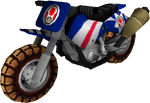 Standard Bike S |
Bike (drift type) | Small | 39
|
21
|
51
|
51
|
54
|
43
|
48
| |||||||||||||||||||||
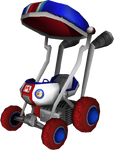 Booster Seat Baby Booster |
Kart | Small | 27
|
27
|
56
|
64
|
37
|
54
|
59
| |||||||||||||||||||||
 Bullet Bike |
Bike (hang-on type) | Small | 53
|
24
|
32
|
35
|
67
|
29
|
67
| |||||||||||||||||||||
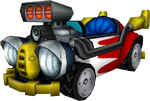 Mini Beast Concerto |
Kart | Small | 55
|
32
|
29
|
32
|
64
|
27
|
64
| |||||||||||||||||||||
 Bit Bike Nanobike |
Bike (drift type) | Small | 25
|
18
|
59
|
67
|
40
|
56
|
62
| |||||||||||||||||||||
 Standard Kart M |
Kart | Medium | 46
|
45
|
40
|
43
|
45
|
35
|
40
| |||||||||||||||||||||
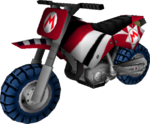 Standard Bike M |
Bike (drift type) | Medium | 43
|
37
|
43
|
45
|
48
|
37
|
43
| |||||||||||||||||||||
 Classic Dragster Nostalgia 1 |
Kart | Medium | 37
|
43
|
59
|
54
|
54
|
40
|
51
| |||||||||||||||||||||
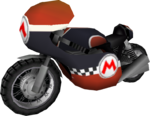 Mach Bike |
Bike (hang-on type) | Medium | 55
|
37
|
24
|
32
|
62
|
27
|
62
| |||||||||||||||||||||
 Wild Wing |
Kart | Medium | 57
|
51
|
21
|
29
|
59
|
24
|
59
| |||||||||||||||||||||
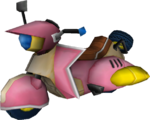 Sugarscoot Bon Bon |
Bike (drift type) | Medium | 32
|
32
|
54
|
62
|
35
|
51
|
56
| |||||||||||||||||||||
 Standard Kart L |
Kart | Large | 48
|
59
|
37
|
40
|
40
|
35
|
35
| |||||||||||||||||||||
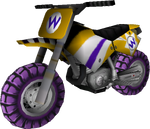 Standard Bike L |
Bike (drift type) | Large | 46
|
54
|
40
|
43
|
43
|
37
|
37
| |||||||||||||||||||||
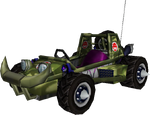 Offroader |
Kart | Large | 39
|
64
|
48
|
54
|
18
|
43
|
45
| |||||||||||||||||||||
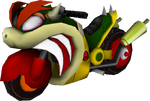 Flame Runner Bowser Bike |
Bike (hang-on type) | Large | 60
|
54
|
18
|
24
|
51
|
21
|
51
| |||||||||||||||||||||
 Flame Flyer |
Kart | Large | 62
|
59
|
16
|
21
|
48
|
18
|
48
| |||||||||||||||||||||
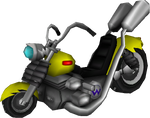 Wario Bike |
Bike (drift type) | Large | 37
|
59
|
51
|
56
|
21
|
45
|
48
|
Unlockable vehicles
| Vehicle | Type | Size | Speed | Weight | Acceleration | Handling | Drift | Off-Road | Mini-Turbo | Unlock methods | |||||||||||||||||||||
|---|---|---|---|---|---|---|---|---|---|---|---|---|---|---|---|---|---|---|---|---|---|---|---|---|---|---|---|---|---|---|---|
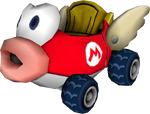 Cheep Charger |
Kart | Small | 34
|
24
|
64
|
56
|
59
|
45
|
54
|
Rank 1 Star in all 50cc Retro Grand Prix Cups / Play 1,800 races | |||||||||||||||||||||
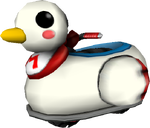 Quacker |
Bike (hang-on type) | Small | 32
|
17
|
67
|
60
|
62
|
48
|
57
|
Win the 150cc Star Cup / Play 2,400 races | |||||||||||||||||||||
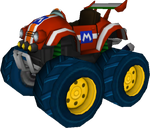 Tiny Titan Rally Romper |
Kart | Small | 46
|
35
|
43
|
43
|
29
|
64
|
40
|
Unlock an Expert Staff Ghost Data record in Time Trials / Play 1,200 races / Win 50 WFC races | |||||||||||||||||||||
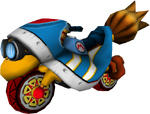 Magikruiser |
Bike (hang-on type) | Small | 43
|
24
|
45
|
45
|
32
|
67
|
43
|
Play Time Trials on 8 different courses / Play 900 races | |||||||||||||||||||||
 Blue Falcon |
Kart | Small | 60
|
29
|
35
|
29
|
43
|
24
|
29
|
Win the Mirror Lightning Cup / Play 4,200 races | |||||||||||||||||||||
 Jet Bubble Bubble Bike |
Bike (hang-on type) | Small | 48
|
27
|
40
|
40
|
45
|
35
|
37
|
Win the Mirror Leaf Cup / Play 3,900 races | |||||||||||||||||||||
 Super Blooper Turbo Blooper |
Kart | Medium | 50
|
40
|
35
|
37
|
21
|
54
|
35
|
Win the 50cc Leaf Cup / Play 300 races | |||||||||||||||||||||
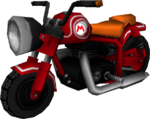 Zip Zip Rapide |
Bike (drift type) | Medium | 41
|
35
|
45
|
51
|
29
|
62
|
45
|
Win the 100cc Lightning Cup / Play 2,100 races | |||||||||||||||||||||
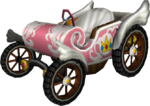 Daytripper Royal Racer |
Kart | Medium | 34
|
45
|
51
|
59
|
32
|
48
|
54
|
Win the 150cc Leaf Cup / Play 2,700 races | |||||||||||||||||||||
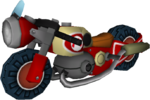 Sneakster Nitrocycle |
Bike (hang-on type) | Medium | 62
|
40
|
29
|
27
|
40
|
24
|
27
|
Rank 1 Star in all 100cc Wii Grand Prix Cups / Play 3,300 races | |||||||||||||||||||||
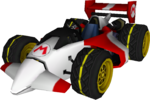 Sprinter B Dasher Mk. 2 |
Kart | Medium | 64
|
48
|
27
|
24
|
37
|
21
|
24
|
Unlock 24 Expert Staff Ghost Data Records in Time Trials / Play 4,650 races / Win 3,000 WFC races | |||||||||||||||||||||
 Dolphin Dasher |
Bike (hang-on type) | Medium | 48
|
43
|
37
|
40
|
24
|
56
|
37
|
Win the Mirror Star Cup / Play 3,750 races | |||||||||||||||||||||
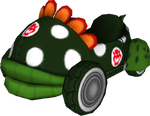 Piranha Prowler |
Kart | Large | 55
|
67
|
29
|
35
|
35
|
29
|
27
|
Win the 50cc Special Cup / Play 600 races | |||||||||||||||||||||
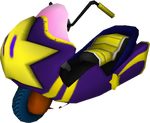 Shooting Star Twinkle Star |
Bike (drift type) | Large | 50
|
48
|
29
|
32
|
59
|
27
|
59
|
Win the 100cc Star Cup / Play 1,500 races | |||||||||||||||||||||
 Jetsetter Aero Glider |
Kart | Large | 69
|
56
|
21
|
17
|
27
|
16
|
16
|
Rank 1 Star in all 150cc Retro Grand Prix Cups / Play 4,500 races | |||||||||||||||||||||
 Spear Torpedo |
Bike (hang-on type) | Large | 67
|
56
|
24
|
18
|
29
|
18
|
18
|
Unlock 12 Expert Staff Ghost Data records in Time Trials / Play 3,600 races | |||||||||||||||||||||
 Honeycoupe Dragonetti |
Kart | Large | 53
|
62
|
27
|
29
|
56
|
24
|
56
|
Win the 150cc Lightning Cup / Play 3,000 races | |||||||||||||||||||||
 Phantom |
Bike (drift type) | Large | 43
|
51
|
43
|
48
|
17
|
56
|
40
|
Win the Mirror Special Cup / Play 4,050 races |
Internal stats
The stats reported do not correspond to all the actual in-game stats.[10][11][12]
Characters' bonuses
There are 20 different kinds of bonuses, which increase a few statistics of the vehicles:
- Weight: Increases the weight of the vehicle.
- Speed: Increases the top speed of the vehicle.
- While Steering: Increases the top speed of the vehicle while steering, expressed as fraction of the top speed.
- Acceleration: Increases the acceleration.
- Standard Acceleration: Increases the first two stage-related acceleration parameters, used when starting from a standstill without mini-turbos (S1 and S2)
- Drift Acceleration: Increases the last two stage-related acceleration parameters, used when the vehicle is near full speed while drifting (S3 and S4)
- Handling: Increases how fast the vehicle can turn regularly (angular velocity).
- Drift: Increases how fast the vehicle can turn while drifting (angular velocity).
- Mini-Turbo: Increases the duration of the Mini-Turbo boost.
- Off-Road Speed: Increases the top speed on each kind of off-road section.
- Off-Road Handling: Increases the Handling on each kind of off-road section.
| Small characters' bonuses | ||||||||||
|---|---|---|---|---|---|---|---|---|---|---|
| Character | Baby Mario | Baby Luigi | Baby Peach | Baby Daisy | Toad | Toadette | Koopa Troopa | Dry Bones | Small Mii | |
| Weight | 0.756 | 0.756 | 0.504 | 0.504 | 0 | 0 | 0 | 0 | 0 | |
| Speed | Standard (km/h) | 0 | 1.06 | 0.53 | 1.06 | 0 | 0.53 | 0 | 0 | 0.53 |
| While steering | 0.000474 | 0.000474 | 0.000474 | 0 | 0.000947 | 0 | 0.000474 | 0.000474 | 0.000947 | |
| Standard Acceleration | S1 | 0 | 0 | 0.025 | 0 | 0.05 | 0 | 0 | 0.025 | 0 |
| S2 | 0 | 0 | 0.035 | 0 | 0.07 | 0 | 0 | 0.035 | 0 | |
| Drift Acceleration | S3 | 0 | 0 | 0 | 0 | 0.18 | 0 | 0 | 0.09 | 0 |
| S4 | 0 | 0 | 0 | 0 | 0.02 | 0 | 0 | 0.01 | 0 | |
| Handling | Manual | 0.00111 | 0 | 0.000555 | 0 | 0 | 0 | 0.000555 | 0 | 0.000555 |
| Auto | 0.00058 | 0 | 0.00029 | 0 | 0 | 0 | 0.00029 | 0 | 0.00029 | |
| Drift | Manual | 0.000529 | 0 | 0 | 0 | 0 | 0 | 0.000265 | 0 | 0 |
| Auto | 0.000444 | 0 | 0 | 0 | 0 | 0 | 0.000222 | 0 | 0 | |
| Mini-Turbo (frames) | 0 | 0 | 0 | 4 | 0 | 0 | 8 | 8 | 4 | |
| Off-Road Speed | Weak Off-road | 0 | 0 | 0 | 0 | 0 | 0.0342 | 0 | 0 | 0 |
| Off-road | 0 | 0 | 0 | 0 | 0 | 0.0368 | 0 | 0 | 0 | |
| Heavy Off-road | 0 | 0 | 0 | 0 | 0 | 0.0226 | 0 | 0 | 0 | |
| Slippery Off-road | 0 | 0 | 0 | 0 | 0 | 0.01283 | 0 | 0 | 0 | |
| Off-Road Handling | Slippery Road | 0 | 0 | 0 | 0 | 0 | 0.00526 | 0 | 0 | 0 |
| Weak Off-road | 0 | 0 | 0 | 0 | 0 | 0.00736 | 0 | 0 | 0 | |
| Off-road and Heavy Off-road | 0 | 0 | 0 | 0 | 0 | 0.00526 | 0 | 0 | 0 | |
| Slippery Off-road | 0 | 0 | 0 | 0 | 0 | 0.00526 | 0 | 0 | 0 | |
| Medium characters' bonuses | ||||||||||
| Character | Mario | Luigi | Peach | Daisy | Yoshi | Birdo | Diddy Kong | Bowser Jr. | Medium Mii | |
| Weight | 0.504 | 0.504 | 0 | 0 | 0.252 | 0.252 | 0 | 0 | 0.252 | |
| Speed | Standard (km/h) | 0 | 0.53 | 0.53 | 1.06 | 0 | 0 | 0 | 0 | 0.53 |
| While steering | 0 | 0.000474 | 0 | 0 | 0 | 0.000474 | 0.000474 | 0.000947 | 0 | |
| Standard Acceleration | S1 | 0.025 | 0 | 0.05 | 0 | 0 | 0 | 0.025 | 0 | 0 |
| S2 | 0.035 | 0 | 0.07 | 0 | 0 | 0 | 0.035 | 0 | 0 | |
| Drift Acceleration | S3 | 0.09 | 0 | 0.18 | 0 | 0.09 | 0 | 0.09 | 0 | 0.09 |
| S4 | 0.01 | 0 | 0.02 | 0 | 0.01 | 0 | 0.01 | 0 | 0.01 | |
| Handling | Manual | 0.000555 | 0 | 0 | 0.000555 | 0 | 0 | 0 | 0 | 0 |
| Auto | 0.00029 | 0 | 0 | 0.00029 | 0 | 0 | 0 | 0 | 0 | |
| Drift | Manual | 0.000265 | 0 | 0 | 0.000265 | 0.000265 | 0 | 0 | 0 | 0.000265 |
| Auto | 0.000222 | 0 | 0 | 0.000222 | 0.000222 | 0 | 0 | 0 | 0.000222 | |
| Mini-Turbo (frames) | 0 | 0 | 0 | 4 | 0 | 8 | 8 | 4 | 4 | |
| Off-Road Speed | Weak Off-road | 0 | 0 | 0 | 0 | 0.0342 | 0.0171 | 0 | 0.0171 | 0 |
| Off-road | 0 | 0 | 0 | 0 | 0.0368 | 0.0184 | 0 | 0.0184 | 0 | |
| Heavy Off-road | 0 | 0 | 0 | 0 | 0.0226 | 0.0113 | 0 | 0.0113 | 0 | |
| Slippery Off-road | 0 | 0 | 0 | 0 | 0.01283 | 0.00641 | 0 | 0.00641 | 0 | |
| Off-Road Handling | Slippery Road | 0 | 0 | 0 | 0 | 0 | 0 | 0 | 0.00263 | 0 |
| Weak Off-road | 0 | 0 | 0 | 0 | 0 | 0 | 0 | 0.00368 | 0 | |
| Off-road and Heavy Off-road | 0 | 0 | 0 | 0 | 0 | 0 | 0 | 0.00263 | 0 | |
| Slippery Off-road | 0 | 0 | 0 | 0 | 0 | 0 | 0 | 0.00211 | 0 | |
| Large characters' bonuses | ||||||||||
| Character | Wario | Waluigi | Donkey Kong | Bowser | King Boo | Rosalina | Funky Kong | Dry Bowser | Large Mii | |
| Weight | 0.252 | 0 | 0.252 | 0.504 | 0 | 0 | 0 | 0 | 0.252 | |
| Speed | Standard (km/h) | 0 | 0 | 0 | 0.53 | 0 | 0.53 | 1.06 | 0 | 0.53 |
| While steering | 0 | 0 | 0.000474 | 0 | 0.000474 | 0.000947 | 0 | 0.000474 | 0 | |
| Standard Acceleration | S1 | 0 | 0.05 | 0.025 | 0 | 0 | 0 | 0 | 0 | 0 |
| S2 | 0 | 0.07 | 0.035 | 0 | 0 | 0 | 0 | 0 | 0 | |
| Drift Acceleration | S3 | 0 | 0.18 | 0 | 0.09 | 0 | 0 | 0 | 0 | 0 |
| S4 | 0 | 0.02 | 0 | 0.01 | 0 | 0 | 0 | 0 | 0 | |
| Handling | Manual | 0 | 0 | 0.000555 | 0 | 0.00111 | 0.000555 | 0 | 0 | 0 |
| Auto | 0 | 0 | 0.00029 | 0 | 0.00058 | 0.00029 | 0 | 0 | 0 | |
| Drift | Manual | 0.000265 | 0 | 0 | 0 | 0.000529 | 0 | 0 | 0 | 0 |
| Auto | 0.000222 | 0 | 0 | 0 | 0.000444 | 0 | 0 | 0 | 0 | |
| Mini-Turbo (frames) | 8 | 0 | 4 | 0 | 0 | 4 | 0 | 8 | 4 | |
| Off-Road Speed | Weak Off-road | 0.0171 | 0.0171 | 0 | 0 | 0.0171 | 0 | 0.0171 | 0.0342 | 0.0171 |
| Off-road | 0.0184 | 0.0184 | 0 | 0 | 0.0184 | 0 | 0.0184 | 0.0368 | 0.0184 | |
| Heavy Off-road | 0.0113 | 0.0113 | 0 | 0 | 0.0113 | 0 | 0.0113 | 0.0226 | 0.0113 | |
| Slippery Off-road | 0.00641 | 0.00641 | 0 | 0 | 0.00641 | 0 | 0.00641 | 0.01283 | 0.00641 | |
| Off-Road Handling | Slippery Road | 0 | 0.00263 | 0 | 0.00263 | 0 | 0 | 0.00526 | 0 | 0.00263 |
| Weak Off-road | 0 | 0.00368 | 0 | 0.00368 | 0 | 0 | 0.00736 | 0 | 0.00368 | |
| Off-road and Heavy Off-road | 0 | 0.00263 | 0 | 0.00263 | 0 | 0 | 0.00526 | 0 | 0.00263 | |
| Slippery Off-road | 0 | 0.00211 | 0 | 0.00211 | 0 | 0 | 0.00422 | 0 | 0.00211 | |
Vehicles' stats
The vehicles have 31 stats. Acceleration is divided in four stages, presumably depending on the actual speed relative to the full speed. In each stage, acceleration is determined by two factors, a stage-specific S factor which is affected by the character bonus and a general E factor. These factors change while drifting, that itself can begin once the vehicle has reached 55% of its top speed. Finally, some stats change depending on the drifting method used (either Manual or Auto) and depending on the fact that the vehicle is steering (While Steering) or not (Standard).
- Weight: The weight of the vehicle.
- Speed: The top speed of the vehicle.
- While Steering: The top speed of the vehicle while steering, expressed as fraction of the top speed.
- Acceleration: How much the relative speed of the vehicle, i.e. the speed expressed as fraction of the top speed, increases over time.
- Handling: How fast the vehicle changes direction over time while steering (angular velocity).
- Range: How much the vehicle swings while steering.
- Drift: How fast the vehicle changes direction over time while drifting (angular velocity).
- Range: How much the vehicle swings while drifting.
- Mini-Turbo: The duration of the Mini-Turbo boost.
- Off-Road Speed: The relative Speed in various Off-Road sections.
- Off-Road Handling: The relative Handling in various Off-Road sections.
- Tilt: How much the kart tilts in various conditions.
| Small vehicles' stats | ||||||||||||||
|---|---|---|---|---|---|---|---|---|---|---|---|---|---|---|
| Vehicle | Standard Kart S | Booster Seat | Mini Beast | Cheep Charger | Tiny Titan | Blue Falcon | Standard Bike S | Bullet Bike | Bit Bike | Quacker | Magikruiser | Jet Bubble | ||
| Weight | 3.05 | 2.84 | 3.26 | 2.63 | 3.47 | 3.05 | 2.42 | 2.63 | 2.21 | 2 | 2.63 | 2.84 | ||
| Speed | Standard (km/h) | 78.71 | 75.53 | 81.89 | 77.12 | 79.77 | 82.95 | 78.18 | 81.36 | 75 | 76.59 | 79.24 | 80.3 | |
| While steering | 0.9957 | 0.9985 | 0.9938 | 0.9933 | 0.9966 | 0.9919 | 0.9962 | 0.9943 | 0.999 | 0.9938 | 0.9971 | 0.9947 | ||
| Acceleration | Not Drifting | S1 | 0.728 | 0.866 | 0.71924 | 0.4795 | 0.89094 | 0.254 | 0.774 | 0.75358 | 0.912 | 0.5 | 0.682 | 0.8566 |
| S2 | 0.728 | 0.866 | 0.3744 | 1.668 | 0.5764 | 0.766 | 0.774 | 0.4148 | 0.912 | 1.75 | 0.682 | 0.536 | ||
| S3 | 0.5034 | 0.5448 | 0.4172 | 0.4418 | 0.5182 | 0.3516 | 0.5172 | 0.4374 | 0.5586 | 0.45 | 0.4896 | 0.498 | ||
| S4 | 0.07034 | 0.07448 | 0.05172 | 0.04418 | 0.06182 | 0.03516 | 0.07172 | 0.05374 | 0.07586 | 0.045 | 0.06896 | 0.0598 | ||
| E | 0.65 | 0.65 | 0.2 | 0.2 | 0.2 | 0.2 | 0.65 | 0.2 | 0.65 | 0.2 | 0.65 | 0.2 | ||
| Drifting | S1 | 0.85 | 0.85 | 0.8 | 0.9 | 0.8 | 0.9 | 0.85 | 0.8 | 0.85 | 0.9 | 0.85 | 0.8 | |
| S2 | 0.95 | 0.95 | 0.925 | 0.975 | 0.925 | 0.975 | 0.95 | 0.925 | 0.95 | 0.975 | 0.95 | 0.925 | ||
| S3 | 1.95 | 1.45 | 2.45 | 2.25 | 1.15 | 1.65 | 2.05 | 2.55 | 1.55 | 2.35 | 1.25 | 1.75 | ||
| S4 | 0.13 | 0.13 | 0.15 | 0.11 | 0.15 | 0.11 | 0.13 | 0.15 | 0.13 | 0.11 | 0.15 | 0.13 | ||
| E | 0.965 | 0.965 | 0.98 | 0.95 | 0.98 | 0.95 | 0.965 | 0.98 | 0.965 | 0.95 | 0.98 | 0.965 | ||
| Handling | Manual | 0.024 | 0.0274 | 0.0205 | 0.0257 | 0.0228 | 0.0199 | 0.0269 | 0.0237 | 0.0301 | 0.0285 | 0.0258 | 0.0248 | |
| Auto | 0.0244 | 0.0267 | 0.0222 | 0.0256 | 0.0237 | 0.0219 | 0.0217 | 0.0205 | 0.023 | 0.0224 | 0.0213 | 0.0209 | ||
| Range | 0.88 | 0.94 | 0.82 | 0.91 | 0.86 | 0.81 | 0.955 | 0.91 | 1 | 0.9775 | 0.94 | 0.925 | ||
| Drift | Manual | 0.0186 | 0.0181 | 0.0198 | 0.0191 | 0.0174 | 0.0167 | 0.0135 | 0.0171 | 0.013 | 0.016 | 0.0136 | 0.0129 | |
| Auto | 0.0209 | 0.0204 | 0.0222 | 0.0214 | 0.0196 | 0.0188 | 0.0146 | 0.0125 | 0.0142 | 0.0119 | 0.0107 | 0.0103 | ||
| Range | 0.94 | 0.92 | 0.99 | 0.96 | 0.89 | 0.86 | 0.95 | 1 | 0.93 | 0.97 | 0.9 | 0.88 | ||
| Mini-Turbo (frames) | 29 | 36 | 39 | 33 | 27 | 22 | 31 | 40 | 37 | 35 | 28 | 26 | ||
| Traction | -15 | 5 | -8 | -3 | 4 | 10 | 1 | 1 | 0 | 3 | 3 | 3 | ||
| Off-Road Speed | Weak Off-road | 0.7039 | 0.7894 | 0.6184 | 0.7381 | 0.8578 | 0.6013 | 0.721 | 0.6355 | 0.8065 | 0.7552 | 0.8749 | 0.6697 | |
| Off-road | 0.4906 | 0.5826 | 0.3986 | 0.5274 | 0.6562 | 0.3802 | 0.509 | 0.417 | 0.601 | 0.5458 | 0.6746 | 0.4538 | ||
| Heavy Off-road | 0.2867 | 0.3432 | 0.2302 | 0.3093 | 0.3884 | 0.2189 | 0.298 | 0.2415 | 0.3545 | 0.3206 | 0.3997 | 0.2641 | ||
| Slippery Off-road | 0.931 | 0.9588 | 0.9032 | 0.9421 | 0.981 | 0.8977 | 0.9366 | 0.9088 | 0.9644 | 0.9477 | 0.9866 | 0.9199 | ||
| Off-Road Handling | Slippery Road | 0.08419 | 0.09997 | 0.06841 | 0.08945 | 0.07893 | 0.06315 | 0.08156 | 0.06578 | 0.09734 | 0.08682 | 0.0763 | 0.07104 | |
| Weak Off-road | 0.12784 | 0.14992 | 0.10576 | 0.1352 | 0.12048 | 0.0984 | 0.12416 | 0.10208 | 0.14624 | 0.13152 | 0.1168 | 0.10944 | ||
| Off-road | 0.08419 | 0.09997 | 0.06841 | 0.08945 | 0.07893 | 0.06315 | 0.08156 | 0.06578 | 0.09734 | 0.08682 | 0.0763 | 0.07104 | ||
| Heavy Off-road | 0.08419 | 0.09997 | 0.06841 | 0.08945 | 0.07893 | 0.06315 | 0.08156 | 0.06578 | 0.09734 | 0.08682 | 0.0763 | 0.07104 | ||
| Slippery Off-road | 0.05743 | 0.07009 | 0.04477 | 0.06165 | 0.05321 | 0.04055 | 0.05532 | 0.04266 | 0.06798 | 0.05954 | 0.0511 | 0.04688 | ||
| Tilt | 0.03 | 0.035 | 0.02 | 0.03 | 0.02 | 0.03 | ||||||||
| Medium vehicles' stats | ||||||||||||||
| Vehicle | Standard Kart M | Classic Dragster | Wild Wing | Super Blooper | Daytripper | Sprinter | Standard Bike M | Mach Bike | Sugarscoot | Zip Zip | Sneakster | Dolphin Dasher | ||
| Weight | 4.31 | 4.1 | 4.73 | 3.89 | 4.31 | 4.52 | 3.68 | 3.68 | 3.26 | 3.47 | 3.89 | 4.1 | ||
| Speed | Standard (km/h) | 79.77 | 77.65 | 82.42 | 80.83 | 77.12 | 84.01 | 79.24 | 81.89 | 76.59 | 78.71 | 83.48 | 80.3 | |
| While steering | 0.9943 | 0.9924 | 0.9928 | 0.9952 | 0.9976 | 0.9909 | 0.9947 | 0.9933 | 0.9981 | 0.9966 | 0.9914 | 0.9957 | ||
| Acceleration | Not Drifting | S1 | 0.59 | 0.4385 | 0.61622 | 0.254 | 0.774 | 0.6849 | 0.636 | 0.65056 | 0.82 | 0.92528 | 0.213 | 0.82226 |
| S2 | 0.59 | 1.504 | 0.2532 | 0.766 | 0.774 | 0.334 | 0.636 | 0.2936 | 0.82 | 0.6168 | 0.602 | 0.4956 | ||
| S3 | 0.462 | 0.4254 | 0.3566 | 0.3516 | 0.5172 | 0.397 | 0.4758 | 0.3768 | 0.531 | 0.5384 | 0.3352 | 0.4778 | ||
| S4 | 0.0662 | 0.04254 | 0.04566 | 0.03516 | 0.07172 | 0.0497 | 0.06758 | 0.04768 | 0.0731 | 0.06384 | 0.03352 | 0.05778 | ||
| E | 0.65 | 0.2 | 0.2 | 0.2 | 0.65 | 0.2 | 0.65 | 0.2 | 0.65 | 0.2 | 0.2 | 0.2 | ||
| Drifting | S1 | 0.85 | 0.9 | 0.8 | 0.9 | 0.85 | 0.8 | 0.85 | 0.8 | 0.85 | 0.8 | 0.9 | 0.8 | |
| S2 | 0.95 | 0.975 | 0.925 | 0.975 | 0.95 | 0.925 | 0.95 | 0.925 | 0.95 | 0.925 | 0.975 | 0.925 | ||
| S3 | 1.75 | 2.05 | 2.25 | 0.85 | 1.25 | 1.45 | 1.85 | 2.35 | 1.35 | 1.15 | 1.55 | 0.95 | ||
| S4 | 0.13 | 0.11 | 0.15 | 0.15 | 0.13 | 0.11 | 0.13 | 0.15 | 0.13 | 0.15 | 0.11 | 0.15 | ||
| E | 0.965 | 0.95 | 0.98 | 0.98 | 0.965 | 0.95 | 0.965 | 0.98 | 0.965 | 0.98 | 0.95 | 0.98 | ||
| Handling | Manual | 0.0228 | 0.0251 | 0.0199 | 0.0216 | 0.0263 | 0.0187 | 0.0258 | 0.0232 | 0.029 | 0.0269 | 0.0221 | 0.0248 | |
| Auto | 0.0237 | 0.0252 | 0.0219 | 0.023 | 0.0259 | 0.0211 | 0.0213 | 0.0203 | 0.0226 | 0.0217 | 0.0198 | 0.0209 | ||
| Range | 0.86 | 0.9 | 0.81 | 0.84 | 0.92 | 0.79 | 0.94 | 0.9025 | 0.985 | 0.955 | 0.8875 | 0.925 | ||
| Drift | Manual | 0.0184 | 0.0186 | 0.0193 | 0.0177 | 0.0177 | 0.0162 | 0.0127 | 0.0164 | 0.0124 | 0.0115 | 0.0119 | 0.014 | |
| Auto | 0.0206 | 0.0209 | 0.0217 | 0.0198 | 0.0198 | 0.0183 | 0.014 | 0.0121 | 0.0138 | 0.0133 | 0.0097 | 0.0108 | ||
| Range | 0.93 | 0.94 | 0.97 | 0.9 | 0.9 | 0.84 | 0.92 | 0.98 | 0.91 | 0.88 | 0.85 | 0.91 | ||
| Mini-Turbo (frames) | 27 | 32 | 36 | 24 | 33 | 19 | 28 | 37 | 35 | 29 | 20 | 26 | ||
| Traction | 3 | -5 | 0 | 5 | -7 | 0 | -2 | 3 | -9 | -4 | -11 | 2 | ||
| Off-Road Speed | Weak Off-road | 0.6697 | 0.7039 | 0.6013 | 0.7894 | 0.7552 | 0.5842 | 0.6868 | 0.6184 | 0.7723 | 0.8407 | 0.6013 | 0.8065 | |
| Off-road | 0.4538 | 0.4906 | 0.3802 | 0.5826 | 0.5458 | 0.3618 | 0.4722 | 0.3986 | 0.5642 | 0.6378 | 0.3802 | 0.601 | ||
| Heavy Off-road | 0.2641 | 0.2867 | 0.2189 | 0.3432 | 0.3206 | 0.2076 | 0.2754 | 0.2302 | 0.3319 | 0.3771 | 0.2189 | 0.3545 | ||
| Slippery Off-road | 0.9199 | 0.931 | 0.8977 | 0.9588 | 0.9477 | 0.8921 | 0.9255 | 0.9032 | 0.9532 | 0.9755 | 0.8977 | 0.9644 | ||
| Off-Road Handling | Slippery Road | 0.07893 | 0.08419 | 0.06578 | 0.07367 | 0.09471 | 0.06052 | 0.0763 | 0.06315 | 0.09208 | 0.08156 | 0.05789 | 0.07104 | |
| Weak Off-road | 0.12048 | 0.12784 | 0.10208 | 0.11312 | 0.14256 | 0.09472 | 0.1168 | 0.0984 | 0.13888 | 0.12416 | 0.09104 | 0.10944 | ||
| Off-road | 0.07893 | 0.08419 | 0.06578 | 0.07367 | 0.09471 | 0.06052 | 0.0763 | 0.06315 | 0.09208 | 0.08156 | 0.05789 | 0.07104 | ||
| Heavy Off-road | 0.07893 | 0.08419 | 0.06578 | 0.07367 | 0.09471 | 0.06052 | 0.0763 | 0.06315 | 0.09208 | 0.08156 | 0.05789 | 0.07104 | ||
| Slippery Off-road | 0.05321 | 0.05743 | 0.04266 | 0.04899 | 0.06587 | 0.03844 | 0.0511 | 0.04055 | 0.06376 | 0.05532 | 0.03633 | 0.04688 | ||
| Tilt | 0.03 | 0.02 | 0.015 | 0.02 | 0.035 | 0.015 | ||||||||
| Large vehicles' stats | ||||||||||||||
| Vehicle | Standard Kart L | Offroader | Flame Flyer | Piranha Prowler | Jetsetter | Honeycoupe | Standard Bike L | Flame Runner | Wario Bike | Shooting Star | Spear | Phantom | ||
| Weight | 5.36 | 5.78 | 5.36 | 5.99 | 5.15 | 5.57 | 4.94 | 4.94 | 5.36 | 4.52 | 5.15 | 4.73 | ||
| Speed | Standard (km/h) | 80.3 | 78.18 | 83.48 | 81.89 | 85.07 | 81.36 | 79.77 | 82.95 | 77.65 | 80.83 | 84.54 | 79.24 | |
| While steering | 0.9943 | 0.9966 | 0.9919 | 0.9928 | 0.99 | 0.9938 | 0.9947 | 0.9924 | 0.9971 | 0.9943 | 0.9905 | 0.9957 | ||
| Acceleration | Not Drifting | S1 | 0.544 | 0.728 | 0.54754 | 0.406 | 0.1515 | 0.6849 | 0.59 | 0.58188 | 0.774 | 0.71924 | 0.172 | 0.89094 |
| S2 | 0.544 | 0.728 | 0.1724 | 0.406 | 0.356 | 0.334 | 0.59 | 0.2128 | 0.774 | 0.3744 | 0.438 | 0.5764 | ||
| S3 | 0.4482 | 0.5034 | 0.3162 | 0.4068 | 0.3106 | 0.397 | 0.462 | 0.3364 | 0.5172 | 0.4172 | 0.3188 | 0.5182 | ||
| S4 | 0.06482 | 0.07034 | 0.04162 | 0.06068 | 0.03106 | 0.0497 | 0.0662 | 0.04364 | 0.07172 | 0.05172 | 0.03188 | 0.06182 | ||
| E | 0.65 | 0.65 | 0.2 | 0.65 | 0.2 | 0.2 | 0.65 | 0.2 | 0.65 | 0.2 | 0.2 | 0.2 | ||
| Drifting | S1 | 0.85 | 0.85 | 0.8 | 0.85 | 0.9 | 0.8 | 0.85 | 0.8 | 0.85 | 0.8 | 0.9 | 0.8 | |
| S2 | 0.95 | 0.95 | 0.925 | 0.95 | 0.975 | 0.925 | 0.95 | 0.925 | 0.95 | 0.925 | 0.975 | 0.925 | ||
| S3 | 1.55 | 0.75 | 1.85 | 1.35 | 1.05 | 2.15 | 1.65 | 1.95 | 0.85 | 2.25 | 1.15 | 0.65 | ||
| S4 | 0.13 | 0.13 | 0.15 | 0.13 | 0.11 | 0.15 | 0.13 | 0.15 | 0.13 | 0.15 | 0.11 | 0.15 | ||
| E | 0.965 | 0.965 | 0.98 | 0.965 | 0.95 | 0.98 | 0.965 | 0.98 | 0.965 | 0.98 | 0.95 | 0.98 | ||
| Handling | Manual | 0.0222 | 0.0251 | 0.0182 | 0.0211 | 0.017 | 0.0199 | 0.0253 | 0.0216 | 0.028 | 0.0232 | 0.0205 | 0.0264 | |
| Auto | 0.0233 | 0.0252 | 0.0207 | 0.0226 | 0.02 | 0.0219 | 0.0211 | 0.0196 | 0.0222 | 0.0203 | 0.0192 | 0.0215 | ||
| Range | 0.85 | 0.9 | 0.78 | 0.83 | 0.76 | 0.81 | 0.9325 | 0.88 | 0.97 | 0.9025 | 0.865 | 0.9475 | ||
| Drift | Manual | 0.0174 | 0.0167 | 0.0184 | 0.0169 | 0.0155 | 0.0191 | 0.0121 | 0.015 | 0.0112 | 0.0141 | 0.0108 | 0.0107 | |
| Auto | 0.0196 | 0.0188 | 0.0206 | 0.0191 | 0.0175 | 0.0214 | 0.0137 | 0.0114 | 0.0131 | 0.0149 | 0.0092 | 0.0127 | ||
| Range | 0.89 | 0.86 | 0.93 | 0.87 | 0.81 | 0.96 | 0.9 | 0.94 | 0.87 | 0.97 | 0.82 | 0.85 | ||
| Mini-Turbo (frames) | 24 | 29 | 31 | 20 | 15 | 35 | 26 | 32 | 31 | 36 | 16 | 27 | ||
| Traction | -15 | 7 | 0 | -13 | 30 | 0 | 0 | 0 | 5 | 27 | 3 | 2 | ||
| Off-Road Speed | Weak Off-road | 0.6697 | 0.721 | 0.5671 | 0.6355 | 0.55 | 0.6013 | 0.6868 | 0.5842 | 0.7381 | 0.6184 | 0.5671 | 0.8065 | |
| Off-road | 0.4538 | 0.509 | 0.3434 | 0.417 | 0.325 | 0.3802 | 0.4722 | 0.3618 | 0.5274 | 0.3986 | 0.3434 | 0.601 | ||
| Heavy Off-road | 0.2641 | 0.298 | 0.1963 | 0.2415 | 0.185 | 0.2189 | 0.2754 | 0.2076 | 0.3093 | 0.2302 | 0.1963 | 0.3545 | ||
| Slippery Off-road | 0.9199 | 0.9366 | 0.8866 | 0.9088 | 0.881 | 0.8977 | 0.9255 | 0.8921 | 0.9421 | 0.9032 | 0.8866 | 0.9644 | ||
| Off-Road Handling | Slippery Road | 0.0763 | 0.08945 | 0.05789 | 0.06578 | 0.05263 | 0.06578 | 0.07367 | 0.05526 | 0.08682 | 0.06315 | 0.05 | 0.0763 | |
| Weak Off-road | 0.1168 | 0.1352 | 0.09104 | 0.10208 | 0.08368 | 0.10208 | 0.11312 | 0.08736 | 0.13152 | 0.0984 | 0.08 | 0.1168 | ||
| Off-road | 0.0763 | 0.08945 | 0.05789 | 0.06578 | 0.05263 | 0.06578 | 0.07367 | 0.05526 | 0.08682 | 0.06315 | 0.05 | 0.0763 | ||
| Heavy Off-road | 0.0763 | 0.08945 | 0.05789 | 0.06578 | 0.05263 | 0.06578 | 0.07367 | 0.05526 | 0.08682 | 0.06315 | 0.05 | 0.0763 | ||
| Slippery Off-road | 0.0511 | 0.06165 | 0.03633 | 0.04266 | 0.03211 | 0.04266 | 0.04899 | 0.03422 | 0.05954 | 0.04055 | 0.03 | 0.0511 | ||
| Tilt | 0.015 | 0.015 | 0.015 | 0.01 | 0.02 | 0.025 | ||||||||
Unlockables
Grand Prix
There is an unlockable for winning the gold trophy for each of the four locked cups for each engine class. There are also unlockables for earning a one-star rank or higher on either all the Wii cups or all the Retro cups for each engine class, and for earning all eight gold trophies for an engine class.
| Class | Star Cup | Leaf Cup | Special Cup | Lightning Cup | 1 Star Wii Cups | 1 Star Retro Cups | 8 Gold Trophies |
|---|---|---|---|---|---|---|---|
| 50cc | King Boo | Super Blooper | Piranha Prowler | Diddy Kong | Baby Daisy | Cheep Charger | 50cc Bikes |
| 100cc | Shooting Star | Dry Bones | Mii Outfit A | Zip Zip | Sneakster | Bowser Jr. | 100cc Karts |
| 150cc | Quacker | Daytripper | Daisy | Honeycoupe | Dry Bowser | Jetsetter | Mirror |
| Mirror | Dolphin Dasher | Jet Bubble | Phantom | Blue Falcon | Rosalina[GP 1] | ||
- ^ If the player does not have a save file of Super Mario Galaxy, Rosalina can be unlocked by earning a 1-star rank or higher on all 8 Mirror cups.
Time Trial / WFC
Unlockables that are not earned in Grand Prix can be earned in Time Trial. Most of the unlockables from Time Trial can also be unlocked via Nintendo Wi-Fi Connection. Each player beaten in a WFC race or battle counts as a win. There are some earned by racing ghosts in the Mario Kart Channel.
| Prize | Time Trial | WFC |
|---|---|---|
| Magikruiser | Play Time Trials on 8 courses. | - |
| Tiny Titan | Unlock an expert Staff Ghost. | Win 50 WFC races. |
| Birdo | Play Time Trials on 16 courses. | Win 250 WFC races. |
| Funky Kong | Unlock 4 expert Staff Ghosts. | Win 25 WFC Ghost races. |
| Toadette | Play Time Trials on 32 courses. | Win 1,000 WFC races. |
| Baby Luigi | Unlock 8 expert Staff Ghosts. | Win 100 WFC Ghost races. |
| Spear | Unlock 12 expert Staff Ghosts. | - |
| Sprinter | Unlock 24 expert Staff Ghosts. | Win 3,000 WFC races. |
| Mii Outfit B | Unlock 32 expert Staff Ghosts. | Win 5,000 WFC Ghost races. |
Race count
Every unlockable character and vehicle can be unlocked by completing a certain number of races or by achieving a specific goal. Battles are counted as races towards the total in all cases.
| Races | Prize |
|---|---|
| 300 | Super Blooper |
| 450 | Diddy Kong |
| 600 | Piranha Prowler |
| 750 | King Boo |
| 900 | Magikruiser |
| 1050 | Dry Bones |
| 1200 | Tiny Titan |
| 1350 | Birdo |
| 1500 | Shooting Star |
| 1650 | Mii Outfit A |
| 1800 | Cheep Charger |
| 1950 | Baby Daisy |
| 2100 | Zip Zip |
| 2250 | Funky Kong |
| 2400 | Quacker |
| 2550 | Toadette |
| 2700 | Daytripper |
| 2850 | Daisy |
| 3000 | Honeycoupe |
| 3150 | Baby Luigi |
| 3300 | Sneakster |
| 3450 | Bowser Jr. |
| 3600 | Spear |
| 3750 | Dolphin Dasher |
| 3900 | Jet Bubble |
| 4050 | Phantom |
| 4200 | Blue Falcon |
| 4350 | Dry Bowser |
| 4500 | Jetsetter |
| 4650 | Sprinter |
| 4950 | Rosalina[R 1] |
| 5100 | Mii Outfit B |
- ^ If the player has a save file of Super Mario Galaxy, Rosalina will appear after 50 races.
Courses
Race courses are divided into various Cups again: Mushroom Cup, Flower Cup, Star Cup, and Special Cup for new courses and Shell Cup, Banana Cup, Leaf Cup, and Lightning Cup for returning courses. Notably, these are the same as in Mario Kart DS.
All thirty-two courses have three laps, regardless of length and difficulty. At first, only two Wii and two Retro Cups are available, but clearing the former two in first place unlocks the Star Cup, while clearing the latter two in first place unlocks the Leaf Cup; likewise, clearing the Star and Leaf Cups in first place unlocks the Special and Lightning Cups, respectively. In Grand Prix mode, this process only applies for the difficulty level the player is in, so it must be repeated for all others to have the secret Cups available in each of them.
This is the first game in the series to have different course names between the American and PAL versions; this applies to DK Summit/DK's Snowboard Cross, Chain Chomp Wheel/Chain Chomp Roulette, and Galaxy Colosseum/Galaxy Arena.
Wii Grand Prix
There are sixteen new courses in Mario Kart Wii.
Retro Grand Prix
These are courses that appeared in previous Mario Kart installments, much like in Mario Kart DS. This includes two courses each from Super Mario Kart and Mario Kart: Super Circuit, and four each from Mario Kart 64, Mario Kart: Double Dash!! and Mario Kart DS. These have been graphically updated and have some new details such as extra trees and ramps, new features such as jumps, pipe tricks, and even added shortcuts. These courses appear in the Shell, Banana, Leaf, and Lightning Cups. This game is tied with Mario Kart 8 Deluxe (when counting the Booster Course Pass) for having the second most retro Mario Circuit courses of any Mario Kart game, with three, behind only Mario Kart Tour, which has six.
Battle stages
This game has the most battle courses of any Mario Kart game, with ten. Additionally, this is the first Mario Kart game with unique music for each battle course.
Tournament arena
This course, structured similar to the battle courses, was only available in certain online tournaments, where it was used as a boss arena against Spiky Topmen.
Staff Ghosts
Each race course in the game has two Staff Ghosts available in Time Trial mode: Normal Staff Ghosts are unlocked by default, while Expert Staff Ghosts are unlocked by setting a good enough record for the course in Time Trials. Unlocking Expert Staff Ghosts can help unlock certain characters and vehicles in the game. Each course's Staff Ghosts both use the same character, but have different vehicles: one is always a kart, the other always a bike. When applicable, the character chosen for each Staff Ghost is usually pertinent to the course, i.e. the "Mario Circuit" courses feature either Mario or Baby Mario. Aside from the Miis, Birdo is the only character not used as a Staff Ghost.
Normal Staff Ghosts
| Course | Staff Name | Time | Character | Vehicle | Wii Wheel | Drift |
|---|---|---|---|---|---|---|
| Luigi Circuit | Nin★sato | 01:29.670 | Luigi | B Dasher Mk 2/Sprinter | Yes | Auto |
| Moo Moo Meadows | Nin★YuNya | 01:37.856 | Baby Daisy | Baby Booster/Booster Seat | Yes | Auto |
| Mushroom Gorge | Nin★Murak | 02:16.110 | Toadette | Quacker | Yes | Manual |
| Toad's Factory | Nin★Misa | 02:22.480 | Toad | Bubble Bike/Jet Bubble | Yes | Manual |
| Mario Circuit | Nin★==Kony | 01:44.777 | Mario | Rapide/Zip Zip | Yes | Manual |
| Coconut Mall | Nin★♪SiMO | 02:30.764 | Daisy | Bon Bon/Sugarscoot | No | Manual |
| DK Summit | Nin★mokke | 02:34.693 | Donkey Kong | Standard Bike L | Yes | Manual |
| Wario's Gold Mine | Nin★morimo | 02:19.585 | Wario | Wario Bike | Yes | Manual |
| Daisy Circuit | Nin★Toki | 01:56.822 | Daisy | Royal Racer/Daytripper | No | Manual |
| Koopa Cape | Nin★Rose | 03:03.022 | Koopa Troopa | Cheep Charger | No | Manual |
| Maple Treeway | Nin★pico | 02:58.633 | Diddy Kong | Nostalgia 1/Classic Dragster | Yes | Manual |
| Grumble Volcano | Nin★Gorin | 02:28.237 | Dry Bowser | Offroader | Yes | Manual |
| Dry Dry Ruins | Nin★Kei | 02:30.949 | Yoshi | Nostalgia 1/Classic Dragster | Yes | Manual |
| Moonview Highway | Nin★KOZ★ | 02:16.802 | Peach | Standard Kart M | Yes | Manual |
| Bowser's Castle | Nin★YABUKI | 03:04.836 | Bowser | Piranha Prowler | No | Manual |
| Rainbow Road | Nin★Konno | 03:05.895 | Rosalina | Twinkle Star/Shooting Star | No | Manual |
| GCN Peach Beach | Nin★HIRO | 01:34.233 | Peach | Royal Racer/Daytripper | No | Manual |
| DS Yoshi Falls | Nin★DoTak | 01:16.461 | Yoshi | Rapide/Zip Zip | No | Manual |
| SNES Ghost Valley 2 | Nin★YOKO | 01:06.595 | King Boo | Standard Kart L | Yes | Manual |
| N64 Mario Raceway | Nin★Ichiro | 02:14.799 | Baby Mario | Nanobike/Bit Bike | Yes | Manual |
| N64 Sherbet Land | Nin★Sakat | 02:48.651 | Baby Luigi | Quacker | Yes | Auto |
| GBA Shy Guy Beach | Nin★Kato | 01:45.568 | Koopa Troopa | Cheep Charger | Yes | Manual |
| DS Delfino Square | Nin★iwaco | 02:41.807 | Wario | Wario Bike | Yes | Manual |
| GCN Waluigi Stadium | Nin★NARI★ | 02:32.882 | Waluigi | Standard Bike L | No | Manual |
| DS Desert Hills | Nin★CHIA | 02:10.233 | Dry Bones | Standard Bike S | No | Manual |
| GBA Bowser Castle 3 | Nin★Fukuda | 02:58.304 | Dry Bowser | Standard Kart L | Yes | Manual |
| N64 DK's Jungle Parkway | Nin★Matt | 02:58.264 | Donkey Kong | Phantom | Yes | Manual |
| GCN Mario Circuit | Nin★♪Miz | 01:59.771 | Mario | Standard Bike M | Yes | Manual |
| SNES Mario Circuit 3 | Nin★iwaco | 01:38.880 | Baby Mario | Standard Kart S | Yes | Manual |
| DS Peach Gardens | Nin★Ito.y | 02:34.894 | Baby Peach | Magikruiser | Yes | Manual |
| GCN DK Mountain | Nin★♪msk | 02:57.744 | Funky Kong | Wario Bike | Yes | Manual |
| N64 Bowser's Castle | Nin★GASK2 | 03:19.323 | Bowser Jr. | Standard Kart M | Yes | Manual |
Expert Staff Ghosts
| Course | Staff Name | Unlock Time | Time | Character | Vehicle | Wii Wheel | Drift |
|---|---|---|---|---|---|---|---|
| Luigi Circuit | Nin★Uta♪ | 01:26.394 | 01:19.419 | Luigi | Mach Bike | Yes | Manual |
| Moo Moo Meadows | Nin★Tkym | 01:34.160 | 01:25.909 | Baby Daisy | Bullet Bike | No | Auto |
| Mushroom Gorge | Nin★Miki | 02:10.875 | 02:01.011 | Toadette | Concerto/Mini Beast | No | Manual |
| Toad's Factory | Nin★GQO | 02:17.653 | 02:05.593 | Toad | Blue Falcon | No | Manual |
| Mario Circuit | Nin★fuyu | 01:40.528 | 01:33.702 | Mario | B Dasher Mk 2/Sprinter | No | Manual |
| Coconut Mall | Nin★MUGI★ | 02:25.620 | 02:13.333 | Daisy | Wild Wing | Yes | Manual |
| DK Summit | Nin★KOZ★ | 02:29.076 | 02:17.546 | Donkey Kong | Flame Flyer | Yes | Manual |
| Wario's Gold Mine | Nin★♪Ryo | 02:15.323 | 02:04.800 | Wario | Flame Flyer | No | Manual |
| Daisy Circuit | Nin★Taeko | 01:51.786 | 01:41.362 | Daisy | Mach Bike | No | Manual |
| Koopa Cape | Nin★morimo | 02:56.867 | 02:41.370 | Koopa Troopa | Bubble Bike/Jet Bubble | No | Manual |
| Maple Treeway | Nin★MUGI★ | 02:51.684 | 02:37.812 | Diddy Kong | Nitrocycle/Sneakster | No | Manual |
| Grumble Volcano | Nin★aki | 02:22.856 | 02:11.852 | Dry Bowser | Torpedo/Spear | No | Manual |
| Dry Dry Ruins | Nin★Akito | 02:26.064 | 02:14.286 | Yoshi | Nitrocycle/Sneakster | Yes | Manual |
| Moonview Highway | Nin★Koh | 02:10.509 | 02:04.163 | Peach | Mach Bike | Yes | Manual |
| Bowser's Castle | Nin★Masa | 02:57.382 | 02:42.098 | Bowser | Bowser Bike/Flame Runner | No | Manual |
| Rainbow Road | Nin★Syun1 | 03:00.007 | 02:44.734 | Rosalina | Aero Glider/Jetsetter | No | Manual |
| GCN Peach Beach | Nin★Taeko | 01:30.909 | 01:23.140 | Peach | Dolphin Dasher | Yes | Manual |
| DS Yoshi Falls | Nin★FJ | 01:14.072 | 01:09.175 | Yoshi | Super Blooper/Turbo Blooper | Yes | Manual |
| SNES Ghost Valley 2 | Nin★sira■ | 01:04.261 | 00:58.907 | King Boo | Torpedo/Spear | No | Manual |
| N64 Mario Raceway | Nin★Yuuki | 02:10.069 | 01:59.053 | Baby Mario | Concerto/Mini Beast | No | Manual |
| N64 Sherbet Land | Nin★FJ | 02:42.536 | 02:28.356 | Baby Luigi | Blue Falcon | No | Manual |
| GBA Shy Guy Beach | Nin★Matt | 01:41.174 | 01:32.867 | Koopa Troopa | Magikruiser | No | Manual |
| DS Delfino Square | Nin★TARO | 02:36.630 | 02:24.169 | Wario | Dragonetti/Honeycoupe | No | Manual |
| GCN Waluigi Stadium | Nin★♪Ryo | 02:26.335 | 02:12.367 | Waluigi | Piranha Prowler | No | Manual |
| DS Desert Hills | Nin★solami | 02:02.358 | 01:52.686 | Dry Bones | Rally Romper/Tiny Titan | Yes | Manual |
| GBA Bowser Castle 3 | Nin★A24 | 02:53.651 | 02:39.391 | Dry Bowser | Bowser Bike/Flame Runner | No | Manual |
| N64 DK's Jungle Parkway | Nin★Syun1 | 02:51.693 | 02:37.782 | Donkey Kong | Flame Flyer | Yes | Manual |
| GCN Mario Circuit | Nin★Dai8 | 01:55.907 | 01:49.939 | Mario | Wild Wing | No | Manual |
| SNES Mario Circuit 3 | Nin★Shige | 01:35.213 | 01:26.659 | Baby Mario | Bullet Bike | No | Manual |
| DS Peach Gardens | Nin★==Kony | 02:29.793 | 02:16.777 | Baby Peach | Concerto/Mini Beast | Yes | Manual |
| GCN DK Mountain | Nin★Miyam | 02:52.100 | 02:38.130 | Funky Kong | Flame Flyer | Yes | Manual |
| N64 Bowser's Castle | Nin★Kentan | 03:09.228 | 02:55.933 | Bowser Jr. | Nitrocycle/Sneakster | Yes | Manual |
Course elements
Enemies, obstacles, and species
These characters and features may either aid the player or act as obstacles and other intractable objects that impede racers if bumped into.
| Character/object | Location | Description |
|---|---|---|
 Angry Sun |
DS Desert Hills | An enemy that appears as part of the scenery and spawns Fire Snakes onto the course. |
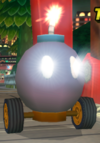 Bob-omb Car |
Moonview Highway | A car that explodes when driven into or hit by a shell. The explosion sends any driver in the vicinity flying. Any driver who runs into the latter frames of the explosion spins out. |
 Bowser Statue |
N64 Bowser's Castle | A large statue of Bowser that burns drivers if they run into its flame. |
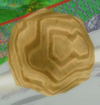 Boulder |
GCN DK Mountain | A large ball of rock that rolls down the course and flips over any driver who runs into it. |
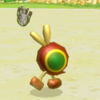 Cataquack |
GCN Peach Beach | An enemy that flips drivers over when touched. Players can temporarily stun Cataquacks by hitting them with shells, POW Blocks, or Lightning, or by driving through them while invincible. |
 Chain Chomp (chained) |
Mario Circuit GCN Mario Circuit DS Peach Gardens |
An enemy that knocks over drivers and causes them to lose their items by ramming into them. Some Chain Chomps are chained to stakes, while others roam freely. Chain Chomps that are chained to stakes lunge at nearby drivers. |
 Chain Chomp (unchained) |
Chain Chomp Wheel | An enemy that appears rolling around in Chain Chomp Wheel. Driving under it smashes players, while flying into its upper regions from a ramp causes players to flip over. |
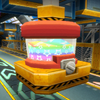 Crusher |
Toad's Factory | Large hydraulic presses that periodically pump down, flattening drivers under it. |
 Delfino Oak Tree |
GCN Mario Circuit | A stationary obstacle that stops players when driven into, serving as a wall. |
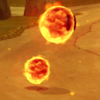 Fire Snake |
Grumble Volcano DS Desert Hills |
A burning snake-like enemy that spins drivers out when touched. In Grumble Volcano, Fire Snakes jump out from pipes, while in DS Desert Hills, they are spawned from the Angry Sun. |
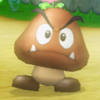 Goomba |
Mushroom Gorge Mario Circuit Koopa Cape GCN Mario Circuit |
A small enemy that spins drivers out when touched. If a driver defeats Goombas with a shell or while invincible, they drop Mushrooms. They can also be defeated with Lightning, although they do not leave any Mushrooms when struck. |
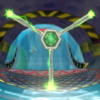 Koopa Zapper |
Koopa Cape | A rotating current of electricity that temporarily shrinks players when touched. Koopa Zappers are similar to the effects of Lightning or a Thunder Cloud, though the duration is shorter. |
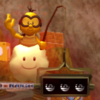 Lakitu |
All courses | The referee of Mario Kart Wii and the entire Mario Kart series. He starts races, keeps track of the laps, announces the winner of a race, and pulls drivers out if they fall off the track. |
 Lava Geyser |
Grumble Volcano Bowser's Castle N64 Bowser's Castle |
A pillar of lava that emerges from either a pool of lava or a crack on the ground. In Bowser's Castle, drivers can perform tricks off the hills generated by the geysers. Drivers who come in contact with Lava Geysers flip over. |
 Mecha Bowser |
Bowser's Castle | A large Bowser-shaped machine that spits out large explosive fireballs that detonate on a blast mark in the stage. Drivers who are hit by a fireball flip over, and they are sent flying if they are caught in the explosion. |
 Mecha Piranha Plant |
GCN Waluigi Stadium | A Piranha Plant-shaped obstacle that acts as a moving wall, emerging from the pipes and stopping any driver who runs into it. |
Mii Drivers |
Coconut Mall | Miis from the player's system who drive cars back and forth. Driving into them flips drivers over and causes them to lose their items. |
 Minecart |
Wario's Gold Mine | A four-wheeled vehicle that travels along the rails in the mine. Drivers who hit minecarts flip over. |
 Moo Moo |
Moo Moo Meadows | A cow that flips drivers over if it is driven into and causes them to lose their items. Moo Moos are first found on the off-road patches of the track but wander onto the road as time goes by. |
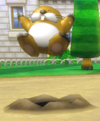 Monty Mole |
Moo Moo Meadows DS Peach Gardens |
An enemy that leaps out of a hole made of dirt. The holes slow drivers down, and any driver who runs into Monty Moles who leap out of these holes flips over. |
 Oil slick |
SNES Mario Circuit 3 | A patch of an oil spill dotted throughout the course. Drivers who go through oil slicks spin out. |
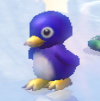 Penguin Slider |
N64 Sherbet Land | A small penguin that waddles and slides back and forth, causing drivers who run into it to spin out. |
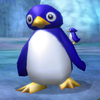 Penguin Waddler |
N64 Sherbet Land | A large penguin found circling a pillar in the cave segment of Sherbet Land. Players who drive into Penguin Waddlers spin out. |
 Piranha Plant |
N64 Mario Raceway GCN Mario Circuit |
A stationary obstacle that spins drivers out when it is touched. The Piranha Plants in GCN Mario Circuit are stationed in Warp Pipes and take bites out of drivers who come nearby, causing them to flip over and lose their items. |
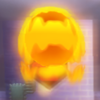 Podoboo |
Bowser's Castle GBA Bowser Castle 3 |
A fiery ball that emerges from lava and causes drivers to spin out. |
 Podoboo Cog |
Bowser's Castle GCN Waluigi Stadium |
A solid eyed cog with three Fire Bars circling it, which cause drivers who touch them to spin out. |
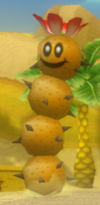 Pokey |
Dry Dry Ruins DS Desert Hills |
A spiky, cactus-like enemy that spins drivers out when touched. Drivers can temporarily destroy Pokeys with shells or Lightning, or by running into them while invincible. |
 Shy Guy Galleon |
GBA Shy Guy Beach | A pirate ship with Shy Guys as part of the scenery that launch explosive cannonballs onto the course. |
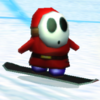 Shy Guy Snowboarder |
DK Summit | A snowboarding Shy Guy that spins out drivers when it is touched. |
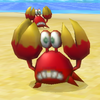 Sidestepper |
GBA Shy Guy Beach | A crab that spins out drivers when it is touched. Drivers can temporarily defeat Sidesteppers with shells, POW Blocks, or Lightning, or by running into them while invincible. |
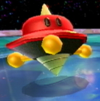 Spiky Topman |
Galaxy Colosseum | An enemy that exclusively appears in Galaxy Colosseum as part of a tournament, where the goal is to knock the Spiky Topmen off the course with Mushroom boosts. |
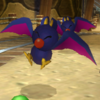 Swooper |
Wario's Gold Mine Dry Dry Ruins |
A bat-like enemy that slows players down when it is driven into. |
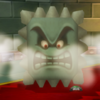 Thwomp |
Bowser's Castle GBA Bowser Castle 3 N64 Bowser's Castle Thwomp Desert |
This enemy smashes drivers if it is directly driven under, and it acts as a wall when simply driven into. In N64 Bowser's Castle, some of the Thwomps slide back and forth. The Thwomp in Thwomp Desert causes the terrain to become uneven, though players can still get smashed by the Thwomp if they are under it when it crashes. |
Vehicles: cars and trucks |
Moonview Highway | Obstacles on the highway that flip players over when they are driven into and squash players that hit them from the front. Characters who are in the Mega Mushroom form can knock cars over but not trucks, while characters under the effects of invincibility from a Star or using a Bullet Bill can knock all vehicles over. |
 Wiggler |
Maple Treeway | A large enemy that wanders around the track and bounces around drivers that bump into it. |
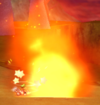 Volcanic debris |
Grumble Volcano | Large balls of fire that spin out any driver who comes in contact with them. |
Background characters
These characters appear as part of the audience or do not affect the character, being part of the course scenery served for world-building purposes.
- Big Cheep Cheeps
- Birdos
- Boos
- Goombas
- Hammer Bros.
- Luma
- Miis
- Monty Moles
- Nokis
- Piantas
- Shy Guys
- Sledge Bros.
- Toads
- Unagi
Items
- For the probability of obtaining each item when an Item Box is opened in the various modes, see Mario Kart Wii item probability distributions.
Mario Kart Wii includes two new items, the Mega Mushroom and the POW Block, and brings back the Thunder Cloud from the Mario Kart Arcade GP installments (making this game its console Mario Kart debut). All three items are absent from Mario Kart 7 and Mario Kart 8. Items can be earned by driving through Item Boxes on the courses, just like in previous games. Once a player has done so, an item will be selected via the Item Roulette. Players can use items by pressing ![]() . In general, players tend to obtain a weak item such as a Banana or a Green Shell when they are in first. However, if players are in a lower place, they obtain a slightly more powerful item such as a Red Shell or Lightning. Usually, the lower the place of the player, the rarer and more powerful the item they get. Stars, Mega Mushrooms, and Bullet Bills are examples of powerful items as they provide speed boosts and invincibility. This is the only game in the Mario Kart series where the drivers do not vocally react to getting inked by a Blooper.
. In general, players tend to obtain a weak item such as a Banana or a Green Shell when they are in first. However, if players are in a lower place, they obtain a slightly more powerful item such as a Red Shell or Lightning. Usually, the lower the place of the player, the rarer and more powerful the item they get. Stars, Mega Mushrooms, and Bullet Bills are examples of powerful items as they provide speed boosts and invincibility. This is the only game in the Mario Kart series where the drivers do not vocally react to getting inked by a Blooper.
| Image | Name | Description |
|---|---|---|

|
Mushroom | Gives players a short speed boost that ignores terrain. |

|
Triple Mushrooms | Gives players three Mushrooms, which give separate boosts. It is the default item in Time Trial mode. |
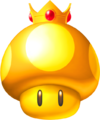
|
Golden Mushroom | The driver gets an infinite number of Mushroom boosts for 7.5 seconds. |

|
Mega Mushroom New item |
The driver grows bigger, which allows them to squash other racers by running over them, making them lose their items and slow down for a moment. The Mega Mushroom makes the racer invincible to all attacks except those from Stars, Bullet Bills, and Bloopers. It allows the user to destroy items and course obstacles and gives the driver a speed boost. In addition, the player can go off-road without suffering any effect of slowing down. The effect lasts for 7.5 seconds but will be ended prematurely if the player is hit by Lightning. |
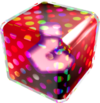
|
Fake Item Box | This item imitates an Item Box but is colored red and has an upside down question mark. At a distance, it appears a similar color to a regular item box, only revealing its true color as the player approaches. It causes opponents to flip over once hit. It cannot block item attacks, but it can be held behind the player's vehicle to block other vehicles. |

|
Banana | When drivers run into a Banana, it causes them to slip and slow down. It can also be held behind the player's vehicle to block attacks from shells and other vehicles. |

|
Triple Bananas | This item gives the driver a trail of three Bananas. |

|
Green Shell | A basic green shell that can be thrown forwards and backwards. It bounces off obstacles several times before it hits an opponent or is destroyed. With each bounce, the new direction is a little corrected to increase the probability of hitting a player. |
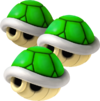
|
Triple Green Shells | Three Green Shells that surround the racer until released. These can also be thrown forward or backward. |

|
Red Shell | A fragile shell that tracks the nearest opponent when fired forward. It will break if it hits an obstacle. |
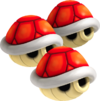
|
Triple Red Shells | Three Red Shells that surround the racer until released. |

|
Spiny Shell | A blue shell that flies directly to the racer in first place and explodes like a Bob-omb. Only one Spiny Shell can be in play at a time, and Spiny Shells are unobtainable for the first 30 seconds of a race. |

|
Star | The driver obtains total invincibility for 7.5 seconds, allowing them to knock over items, course obstacles, and other players on contact. Also, the driver receives a speed boost and the power to drive off-road with no speed loss. Racers that are hit will lose all items in their possession. |

|
Lightning | Lightning strikes every racer ahead of the user, causing them to spin out, drop their items, and shrink to a very small size, driving more slowly. This item takes no effect on racers with invincibility items activated. The effects wear off from lowest place to first. Any users with the Mega Mushroom in effect shrink to normal size. Only one Lightning can be in play at a time, and it has a cooldown timer both for the first 30 seconds of a race and for 30 seconds between uses. |

|
Thunder Cloud New item in console Mario Kart |
A thundercloud hovers over the recipient and strikes it with lightning after 10 seconds. The user shrinks to a very small size for 10 seconds, driving more slowly. Before this happens, the user has higher speed and acceleration while not losing speed when driving off-road, and may pass the cloud to an opponent by bumping into them. The Thunder Cloud can be destroyed if the driver goes into a cannon or uses a Star or Mega Mushroom. Only one Thunder Cloud can be in play at a time. |

|
Bob-omb | Blows up a racer anywhere on the track. It has the same effect as the Spiny Shell, except that it can be lobbed or tossed backwards just like a Banana. |
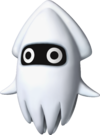
|
Blooper | Squirts ink on any racer ahead of the user, partially obscuring vision. It eventually wears off, but it can be immediately removed by a speed boost from a Mushroom, Dash Panel, etc. The higher the player's position is, the more their vision is obscured. Only one Blooper can be in play at a time, and it has a cooldown timer both for the first 15 seconds of a race and for 15 seconds between uses. |

|
Bullet Bill | Transforms the racer into a large Bullet Bill, which rockets down the entire track at very high speeds on autopilot. The Bullet Bill provides total invincibility and will knock over any item, any course hazard, and any player that is in the way, making them lose or drop all their items. Only one Bullet Bill can be in play at a time. |

|
POW Block New item |
The POW Block appears above the karts as a 2D image, warning players of its arrival, and causes any racer on the ground ahead of the user to spin out and drop their items. Players who deploy the wheelie button at the moment the POW Block hits mitigate the spinout by retaining their speed. Players can also be airborne to avoid the POW Block, as the POW Block will not affect any racer that is in the air. Only one POW Block can be in play at a time, and it has a cooldown timer both for the first 20 seconds of a race and for 20 seconds between uses. |
Brands
- Main article: List of brands debuting in Mario Kart Wii
Alongside new brands, several brands return from previous games, both in classic courses and in new courses.
New
- 1-Up Coffee
- Aquarium
- Beauty Maniac
- Bullet Oil
- Café de Mario
- Coco Burger
- Coco Coffee
- Coco Cute
- Coco Mode
- Coco Outfitters
- Coco Pet Foods
- Coconut Cafe
- Coconut Fruit
- Daisy Candy
- Delfino Dream
- Faces
- Factory
- Fire Flower Oil Company
- Fountain Cafe
- Fun Flower
- Gold Star Bank
- Green Fuel
- Item Box
- Lady Coco
- Luigi Kart
- Mario Grand Prix
- Mario Kart Milk
- Matu World
- Moo Moo Dairy
- Moon Bank
- Mushroom Mart
- Mushroom Moon
- Nintendo Moo Moo Farm
- Shell Island
- Shooting Star
- Showtime!
- Sweet Cake
- Tropica
- Tropical Bakery
- Tropical Grocery
- Tropical Mart
- Yoshi
Returning
- Big Fire!!!
- Dangerous!!!
- Delfino Fruits
- Koopa Shop
- KoopaKart
- Luigi Grand Prix
- Luigi Grand Prix
- Mario Kart (Nintendo-style banner)
- Mario Kart (Toad banner)
- Mario Kart / Nintendo GameCube
- Mario Racing
- Peach Grand Prix
- Princess Daisy
- Shoot!!
- Sunshine
- Sunshine Parts
- Super Mario
- Super Mario GP
- Super Mushroom
- Super Wario
- Waluigi Grand Prix
- Waluigi Kart
- Waluigi Oil
- Wario GP
- Wario Kart
- Wario Racing
- Yoshi Kart
- Yoshi's Egg
Differences in multiplayer modes
As in the previous games in the Mario Kart series, there are several small changes made to the courses in split-screen mode, most likely to preserve the frame-rate.
- At the start of a race, Lakitu is next to the player driver, slightly facing the side of the track. In single player mode, he is in front of the player driver, facing the camera. This only counts for races, however, as Lakitu always starts next to the player when in a battle.
- The question marks in the Item Boxes spin around with the box. They are static in single player mode.
- Frame-rate slows to 30 frames per second if the screen is split 4 ways or is in Two Player Online.
- The fourth screen in local three player play displays a dynamic camera that rotates between the three player drivers.
- CPUs do not animate. In Battle Mode, their voices are also absent.
- There are no tourists on the Sunshine cruise ship in GCN Peach Beach.
- Boos do not animate in SNES Ghost Valley 2.
- In GCN Waluigi Stadium, the metal Piranha Plants do not move their jaws, and the moving arrow signs and the Jumbotron are absent as in Mario Kart: Double Dash!!
- There are no Miis in the stores in Coconut Mall.
- The crowd in Mario Circuit, Toad's Factory, Daisy Circuit, and DS Delfino Square do not animate.
- No tourists are on the ship in N64 DK's Jungle Parkway.
- The Jumbotron at Funky Stadium does not show the human player; instead it shows a picture of Funky Kong's face with the words "Funky Stadium".
- Star Bits are missing in Rainbow Road.
Staff
- Main article: List of Mario Kart Wii staff
Consistent with the rest of the console Mario Kart series, Mario Kart Wii is developed by Nintendo EAD. Shigeru Miyamoto is the general producer of the game, with the producer being Hideki Konno, who had been consistently involved with the Mario Kart series since the first installment, except Mario Kart: Double Dash!!, and the executive producer being Satoru Iwata. Yasuyuki Oyagi directed the game, having co-directed the series since Mario Kart 64 barring Mario Kart: Super Circuit, though Mario Kart Wii was the first installment he was the sole director of and the last installment he directed, becoming a co-producer later on. Mario Kart Wii was the debut of Kosuke Yabuki as a planner; he would later become key staff and serving a director role in later Mario Kart installments.
Pre-release and unused content
- Main article: List of Mario Kart Wii pre-release and unused content
Unused graphics have been found depicting icons for a Hammer Bro, a Koopa Paratroopa, and Petey Piranha, presumably being an extra character for each weight class. An outfit for the NPC Miis has also been found, which resembles a Toad.
An unused select Icon for Koopa Paratroopa as a player
An unused select Icon for Hammer Bro as a player
An unused select Icon for Petey Piranha as a player
Glitches
- Main article: List of Mario Kart Wii glitches
Note: All names are conjectural unless otherwise specified.
Grumble Volcano lap glitch
This shortcut can be done by jumping the large rock to the left of the starting line in Grumble Volcano. If the player drives around it correctly, they will complete a lap.
Incorrect number of players
Rarely, when the player finishes an online race, if the next race has 12 players, the game will say it has 13 players instead.
Miscolored Item Boxes
To perform the glitch, the player needs to start a team race on the blue team. If the player starts a solo race, some racers' Fake Item Boxes will be blue instead of red.
Promotion
- Main article: List of Mario Kart Wii trading cards
Trading cards were released to celebrate the release of Mario Kart Wii. Trading card packs additionally included tattoos called FunTats.
For the marketing of Mario Kart Wii in the United States only, Nintendo of America did a series of three commercials starring Cowboy Jed, primarily to promote their slogan for this game: "Get Behind The Wheel!". The slogan focuses on the Wii Wheel, Nintendo's targeted gameplay control, as stated earlier in this article.
Reception
Critical reception
Mario Kart Wii has received positive reviews from critics. It has an average score of 82.07% from 74 reviews in GameRankings and an average of 82 based on 73 reviews on Metacritic.[13][14]
Bozon of IGN gave the game an 8.5 out of 10, praising the online play, the presentation, and the gameplay but criticizing the cheap AI in 150cc, the lack of voice chat, reliance on friend codes, and the random items. He finished off with, "Every player is going to have their own love/hate relationship with Mario Kart Wii, but in the end the game does so many things right that it'd be foolish not to give credit where due. Online seriously raises the bar for Nintendo, trumping even Smash in a big, big way. The sense of community you can get even with random racers online and ghost-supported leader boards is impressive, and the fact that you can head on to Nintendo Wi-Fi Connection solo, with a friend via split-screen, or hook up with buddies across the world without worry of lag and never-ending disconnect notices makes Mario Kart Wii a pure joy to play online. It isn't the best Mario Kart in the series, but it's a must-play experience on Wii, and standard-setting offering as far as online, channel support, and connectivity are concerned. Now if you'll excuse us, we've got some online stats to obsess over."[15] Sammy Barker of Nintendo Life praised the game for its polished gameplay and being well-thought and brilliant. Though he criticized the presentation, he wrote, "Poor presentation should not be an issue in this generation of gaming, particularly with the other consoles doing it so well, but, thankfully for us (as Wii owners), this game is a living, breathing example of gameplay over graphics." He gave the game 9/10 stars.[16] Oli Welsh of Eurogamer gave the game a score of 8/10. He praised the presentation of the game, the use of the Wii Wheel, and the smooth gameplay while criticizing the Battle Mode and the single player exclusive Grand Prix mode (though this was revised after being informed by Nintendo that four sequences of races with friends is still possible). He wrote, "Ultimately, the sheer sensory pleasure of playing Mario Kart Wii - from the charming animations, to the bopping tunes, to the sugar-rush boosting, to the exquisite steering - far overcomes the few concerns we have about it. It still has to be docked a mark for the awkward structure and compromised battle modes - but it's still unreservedly recommended to anyone for whom Mario Kart is a gaming cornerstone. And really, that should be everyone."[17]
Ryan Davis of Giant Bomb criticized the game for being safe. He wrote, "Mario Kart Wii is a good game stunted by its audience's apparently insatiable appetite for the exact same thing, over and over again. The addition of online play and motion controls are good, but they're also the most predictable choices possible. Personally, I'm completely tired of getting exactly what I expect." He gave the game a 3 out of 5 stars.[18] Edge gave the game 6/10, criticizing the game's compromising local, splitscreen multiplayer for online play. They ended with "Undercutting local multiplayer to benefit the online movement is a grievous error. Of all the multiplayer franchises, we struggle to think of a title in which four friends sat side by side seemed more natural. Having sacrificed racing integrity in Double Dash to side with social silliness, Nintendo has turned 180 degrees into an awkward halfway house. It’s a residence from where it has attempted to regain time-trial credentials with the loosest racing yet, and sees the company finally find its online feet by betraying one of its great pastimes. Perhaps first place in Mario Kart Wii isn’t the least enjoyable location in gaming after all."[19]
| Reviews | |||
|---|---|---|---|
| Reviewer, Publication | Score | Comment | |
| Nintendo Power | 9/10 | With more features, modes and multiplayer options than ever before, fans should be revved up to get behind the wheel. [May 2008, p.86]. | |
| Official Nintendo Magazine UK | 9.4/10 | A fantastic racer and the best online Nintendo game ever. [Apr 2008, p.58] | |
| Bozon, IGN | 8.5/10 | There are some things that feel completely out of whack though, such as the uncharacteristically cheap AI in 150cc, the lack of voice chat for an extremely social online game, reliance on friend codes, and "everyone's a winner" feeling you get when random items show up and completely turn the game upside down in an instant. | |
| Bryn Williams, GameSpy | 4.5/5 | The offline and online content is extremely entertaining and the pursuit of casual and hardcore karting has never been this much fun. | |
| Greg Leahy, Nintendo World Report | 8.5/10 | Mario Kart Wii is ultimately much the same game as Mario Kart DS, but this is forgivable due to its drastically improved online functionality along with some welcome gameplay additions and tweaks. | |
| Lark Anderson, GameSpot | 8.5/10 | Mario Kart Wii offers varied multiplayer and thoroughly integrated online modes that will keep you coming back for more. | |
| Oli Welsh, Eurogamer | 8/10 | Ultimately, the sheer sensory pleasure of playing Mario Kart Wii - from the charming animations, to the bopping tunes, to the sugar-rush boosting, to the exquisite steering - far overcomes the few concerns we have about it. It still has to be docked a mark for the awkward structure and compromised multiplayer modes - but it's still unreservedly recommended to anyone for whom Mario Kart is a gaming cornerstone. | |
| Electronic Gaming Monthly | 6.4/10 | While Mario Kart Wii is predictably similar to its predecessors, something has changed with this installment. Something that makes it feel subtly unlike other Mario Karts--and not a change for the better. [June 2008, p.73] | |
| Edge Magazine | 6/10 | Having sacrificed racing integrity in "Double Dash" to side with social silliness, Nintendo has turned 180 degrees into an awkward halfway house. [May 2008, p.86] | |
| Chris Kohler, Wired | 6/10 | [Mario Kart Wii's Battle Mode] is no longer a last-man-standing contest: Matches now last three minutes each, and if your kart takes too much damage, don't worry! You'll just respawn. Even worse, all battles are now played in teams of two. So while you can still have four human players, they can't all face off against each other -- and what's the point of that? | |
| Ryan Davis, Giant Bomb | 6/10 | Personally, I’m completely tired of getting exactly what I expect. | |
| Aggregators | |||
| Compiler | Platform / Score | ||
| Metacritic | 82 | ||
| GameRankings | 82.07% | ||
Awards
Mario Kart Wii won the "Favorite Video Game" award at the Nickelodeon 2010 Kids' Choice Awards, beating out The Legend of Zelda: Spirit Tracks, Wii Fit, and Wii Sports Resort. The game won the Best Online Multiplayer Game from IGN in 2008.[20] In the Guinness World Records 2010 Gamer's Edition, Mario Kart Wii won the "Best-selling racing game" accolade.[21]
Sales
In the week of May 4, 2008 in Japan, Mario Kart Wii became the best-selling game for the Wii, having sold over a million copies in Japan, less than a month after its release.[22] In the UK, Mario Kart Wii was the 8th biggest selling video game in British history and the single best-selling Nintendo game in history.[23] In the United States, at the month's release, Mario Kart Wii was the second best-seller at 1.12 million copies, being beaten out by the Xbox 360 version of Grand Theft Auto IV, but outselling the PS3 version of Grand Theft Auto IV.[24] Mario Kart Wii currently is the second best-selling game on the Wii, beaten out by Wii Sports, and in turn the best-selling Super Mario game on the system; the game has sold a total of 37.38 million units as of December 31, 2020, and was originally the best-selling Mario Kart game and the best-selling racing video game of all time, before being overtaken by Mario Kart 8 Deluxe in September 30, 2021.
Gallery
- For this subject's image gallery, see Gallery:Mario Kart Wii.
Toad driving his Cheep Charger
Waluigi riding his Standard Bike L
Bowser driving his Flame Flyer holding a Spiny Shell
Luigi Circuit group picture artwork
Music and sound
Mario Kart Wii is the first game before Mario Kart 8 to feature revamped music for retro courses. In this case, the SNES and GBA tracks received revamped songs, as well as some of the battle stages. Tracks from the N64 and DS had their songs slightly enhanced in sound quality. The GCN tracks, however, remained relatively the same. This trait is also kept in Mario Kart 7 as well. It is also the first and currently only game that cuts off the tracks' intros in the final lap.
The soundtrack was created using Best Service's Advanced Orchestra and Gigapack, EastWest's Stormdrum and Quantum Leap Brass, E-MU Systems' Proteus/3, Korg Triton Le, ILIO's Synclavier Essential Percussion and World & Orchestra, Roland's D-550, Fantom X7 and Sound Canvas SC-8850, Spectrasonics' Distorted Reality and Supreme Beats, Ueberschall's House Essentials and Zero-G's Jungle Warfare.[25]
Soundtrack
- Main article: Mario Kart Wii Platinum Soundtrack
An official soundtrack was released in 2011 by Club Nintendo as a Platinum reward featuring 43 songs from the game itself.
Multimedia
- For the complete list of media files for this subject, see Multimedia:Mario Kart Wii.
| File info 0:30 |
| File info 0:30 |
| File info 0:30 |
| File info 0:30 |
References to other games
- The POW Block's logo appears in some of the cars in Moonview Highway and appears as an item.
- Sprites of the ? Block, Super Mushroom, Fire Flower, and Super Star appear in the background of the Battle course Block Plaza.
- Sprites of Mario, Luigi, and a Super Mushroom can be seen on signage and the balloon in Mario Circuit.
- The start of the music that plays on Bowser's Castle features an arragement of the Castle BGM.
- When bumped into, a racer's vehicle makes one of several beeping noises, two of which are the first six notes of the Ground BGM and the power-up sound effect.
- The license plates on some of the trucks read "SMB3", the abbreviation of Super Mario Bros. 3.
- The Tiny Titan was inspired by the Monster.
- Ghost Valley 2 and Mario Circuit 3 return as retro courses.
- Battle Course 4 returns as a playable battle course.
- An arrangement of "Awards Ceremony (1st – 3rd Place)" plays during the Award Ceremony.
- Unagi appear in the background of Koopa Cape and Chain Chomp Wheel.
- Mario Raceway, Sherbet Land, DK's Jungle Parkway, and Bowser's Castle return as retro courses.
- Skyscraper returns as a playable battle course.
- The course Moo Moo Meadows is based on Moo Moo Farm, and Block Plaza has parts of Block Fort.
- Shy Guy Beach and Bowser Castle 3 return as retro courses.
- Battle Course 3 returns as a playable battle course.
- The Yoshi Sphinx from the background of GBA Yoshi Desert returns as a part of the race course Dry Dry Ruins.
- The battle stage Delfino Pier is based on Delfino Plaza.
- The course Coconut Mall is seemingly located on Isle Delfino.
- WarioWare series
- The Wario Bike appears as a selectable vehicle.
- Peach Beach, Waluigi Stadium, Mario Circuit, and DK Mountain return as retro courses.
- Cookie Land returns as a playable battle course
- All of these courses retain their intros as retro tracks.
- Daisy Cruiser cameos in the background of Daisy Circuit.
- Block Plaza has parts of Block City.
- The course Dry Dry Ruins has the same starting point as Dry Dry Desert.
- The character icons and the starting race jingle for Grand Prix races was also recycled from that game for VS. and Grand Prix races in this game, along with the 3-2-1 starting countdown, but with "GO!" at the end instead of "START".
- Some of the animations seen for the driver selection process for returning drivers are reused, and the 1st and 6th-12th kart animations are reused from Double Dash!!'s primary 1st-3rd and 4th-8th place animations.
- All character models are ported from Double Dash!! as well, with only a few characters receiving noticeable changes.
- On the save file/driver's license screen, the Star Cup uses the same icon.
- On Daisy Circuit, Daisy's artwork from this game can be seen on the "Daisy Candy" sponsor sign.
- Dry Bones and Boo's artwork can be seen in Bowser's Castle on the "Showtime!" billboard.
- Toadette's artwork is reused from this game.
- Yoshi Falls, Delfino Square, Desert Hills, and Peach Gardens return as retro courses.
- Twilight House returns as a playable battle course.
- All of these courses' intros return in this game.
- The course DK Summit has derived many elements from DK Pass.
- The course Dry Dry Ruins has similar music to that of Desert Hills.
- The countdown sound effect for starting races and battles are recycled from that game to signal the start of the race in Grand Prix, Time Trial, and VS mode.
- The Zipper is a bike that relates to the Shooting Star and the ROB-LGS acts like the Standard Bikes in the game. The opening portion of the theme for Rainbow Road is taken from Rainbow Road's music from this game. A portion of the Figure-8 Circuit and Mario Circuit theme from this game can be heard as Lakitu flies on-screen during the trophy ceremony.
- Various environmental features in the game use their New Super Mario Bros.-designs, such as the yellow hills seen in several Wii courses, the outcrops of Luigi Circuit, the flowers and mushrooms of Moo Moo Meadows, and the spotted hills of Mushroom Gorge.
- The Mega Mushroom returns as an item alongside its associated theme.
- Mushroom Gorge takes heavy inspiration from this game's athletic levels, featuring red and green Mushroom Platforms with the red variant assuming the bounciness of Mushroom Trampolines.
- Grumble Volcano is based on World 8, with returning features including the volcano aesthetic, dead trees, volcanic debris, and overall color palette alongside decorative ? Blocks and bricks that use their designs from this game.
- Dry Bowser, who first appears in New Super Mario Bros., returns to Mario Kart Wii as his second appearance.
- Princess Peach's profile artwork is reused.
- Daisy's artwork from this game is also reused, but with her kart added to it.
- Rainbow Road has several elements from said game, such as Star Bits or a section based on Launch Stars, and portions of the Good Egg Galaxy's music is heard for the course's music.
- Maple Treeway resembles the Gold Leaf Galaxy.
- The battle course Galaxy Colosseum is heavily based on Super Mario Galaxy.
- Spiky Topmen are the enemies in the June 2008 1st Competition.
- Rosalina, who first appears in Super Mario Galaxy, returns to Mario Kart Wii as her second appearance.
References in later games
- Mario Sports Mix
- In Toad Park, the Standard Kart design is used from this game.
- Mushroom Gorge, Coconut Mall, Maple Treeway and Koopa Cape return as Retro Courses.
- Tricks, which are first introduced here, are reused in this game as well as the character icons and countdown timer for starting races and battles.
- Tricks, Bikes, twelve-player races, and the ability to look behind return.
- Moo Moo Meadows, Grumble Volcano, and Wario's Gold Mine return as Retro Courses (Wario's Gold Mine was added via DLC, but is available from the start in Mario Kart 8 Deluxe).
- Coconut Mall, Mushroom Gorge, Maple Treeway, DK Summit, Moonview Highway, Koopa Cape, Daisy Circuit, and Rainbow Road return as part of the Booster Course Pass in Mario Kart 8 Deluxe.
- The Bowser's Castle in this game sees the return of a similar giant moving Bowser statue that players drive around.
- Peach, Daisy, and Rosalina wear their bike suits again when riding a bike or ATV.
- The Launch Star boosters from Rainbow Road also return in the remastered N64 Rainbow Road in this game.
- Mushroom Gorge is one of the few songs that can be heard at the stage Mario Circuit.
- The Standard Bike M, Daytripper, Flame Runner, Quacker, and Offroader all appear as trophies.
- The POW Block item causes the Shy Guy racers in Mario Circuit to spin out when used.
- The Standard Kart, Standard Bike, and Cheep Charger appear as spirits.
- Mushroom Gorge, Coconut Mall, DK Summit, Daisy Circuit, Koopa Cape, Maple Treeway, Dry Dry Ruins, Moonview Highway, and Rainbow Road appear as returning courses.
- The Cheep Charger, Wild Wing, Super Blooper, Sprinter (using its British English name), Daytripper, Offroader, Flame Flyer, and Jetsetter (renamed the Speeder) return as karts in this game.
- The jingle that plays when obtaining a level-boost ticket for a High-End kart, racer, or glider is recreated.
- Funky Kong's emblem from Mario Kart Wii appears on some plane wreckage in the background of Big Top Bop.
- An arrangement of Maple Treeway's music plays in the Tranquil Pipes Teahouse at Shogun Studios.
- Moo Moo Meadows and Toad's Factory appear as returning courses.
- Arrangements of "Luigi Circuit/Mario Circuit", "Mushroom Gorge", "Coconut Mall", "DK Summit", "Wario's Gold Mine", "Daisy Circuit", "Maple Treeway", "Grumble Volcano", "Dry Dry Ruins", "Moonview Highway", "Rainbow Road", and "Staff Roll A" are among the songs that can play on the main menu, in Free Roam, or during routes in Grand Prix and VS Mode.
Names in other languages
| Language | Name | Meaning | Notes |
|---|---|---|---|
| Japanese | マリオカートWii[?] Mario Kāto Wī |
Mario Kart Wii | |
| Chinese (simplified) | 马力欧卡丁车Wii[26] Mǎlì'ōu Kǎdīngchē Wii |
Mario Kart Wii | |
| Chinese (traditional) | 瑪利歐賽車 Wii[27] Mǎlì'ōu Sàichē Wii |
Mario Racing Wii | |
| Korean | 마리오 카트 Wii[?] Mario Kateu Wii |
Mario Kart Wii |
Notes
- The save data description is "Race for first!" in the NTSC version and "Race for 1st place!" in the PAL version.
- In the opening cutscene, Peach can be seen racing with her hair untied. She always wears a ponytail in-game.
- This is the first Mario Kart in which not every new circuit course shares the same background music, as Daisy Circuit features its own unique music track instead of sharing a music track with Luigi Circuit and Mario Circuit.
References
- ^ マリオカートWii. Nintendo Co., Ltd. (Japanese). Retrieved March 21, 2008.
- ^ Nintendo :: Games :: Mario Kart Wii. Nintendo of America (American English). Archived December 13, 2007, 03:19:15 UTC from the original via Wayback Machine. Retrieved May 29, 2018.
- ^ Club Nintendo (MX) issue 198. Page 76.
- ^ North American box cover
- ^ Mario Kart Wii | Wii | Игры | Nintendo. Nintendo of Europe GmbH (Russian). Archived July 22, 2014, 20:24:31 UTC from the original via Wayback Machine. Retrieved November 11, 2025.
- ^ IR Information : Sales Data - Top Selling Software Sales Unites - Wii Software. Nintendo (English). Retrieved July 3, 2024.
- ^ Wii - Mario Kart Wii - Country Flags. The Spriters Resource (English). Retrieved July 3, 2024.
- ^ Casamassina, Matt (February 27, 2008). Update: Mario Kart Wii Text Chat Details. IGN. Retrieved July 3, 2024.
- ^ a b Mario Kart Wii Stat Table (PNG). ark42.com (English). (Archived May 28, 2024, 10:29:02 UTC via Wayback Machine.)
- ^ A direct transcription of the content of the driverparam.bin and kartParam.bin files in the /Race/Common.szs archive of the filesystem of Mario Kart Wii. Google Docs (English). Retrieved July 3, 2024.
- ^ driverParam.bin. Custom Mario Kart Wiiki. Retrieved September 5, 2023.
- ^ kartParam.bin. Custom Mario Kart Wiiki. Retrieved September 5, 2023.
- ^ Mario Kart Wii. GameRankings (English). Archived April 10, 2016, 05:58:02 UTC from the original via Wayback Machine. Retrieved July 3, 2024.
- ^ Mario Kart Wii. Metacritic. Retrieved July 3, 2024.
- ^ Bozon (April 20, 2008). Mario Kart Wii Review. IGN (English). Retrieved July 3, 2024.
- ^ Barker, Sammy (April 14, 2008). Review: Mario Kart Wii. Nintendo Life (English). Retrieved July 3, 2024.
- ^ Welsh, Oli (March 20, 2008). Mario Kart Wii Review. Eurogamer (English). Retrieved July 3, 2024.
- ^ Davis, Ryan (May 7, 2008). Mario Kart Wii review. Giant Bomb (English). Retrieved July 3, 2024.
- ^ April 14, 2008. Mario Kart Wii review. Edge (English). Archived June 17, 2013, 17:07:57 UTC from the original via Wayback Machine. Retrieved July 3, 2024.
- ^ IGN Wii: Best Online Multiplayer Game. IGN. Archived December 22, 2008, 04:08:59 UTC from the original via Wayback Machine. Retrieved July 3, 2024.
- ^ Funk, John (May 21, 2010). Mario's Ten Best Guinness World Records. The Escapist (English). Archived May 25, 2010, 02:10:39 UTC from the original via Wayback Machine. Retrieved July 3, 2024.
- ^ McWhertor, Michael (March 8, 2008). Ain't No Stopping Mario Kart Wii In Japan. Kotaku (English). Retrieved July 3, 2024.
- ^ Sales Charts British Sales Charts. Kotaku (English). Archived April 20, 2008, 05:26:52 UTC from the original via Wayback Machine. Retrieved March 5, 2018.
- ^ Sinclair, Brendan (June 5, 2008). NPD: US April game revs spike on GTAIV. GameSpot (English). Retrieved March 5, 2018.
- ^ Newer VGM Sound Sources. Google Docs (English). Retrieved July 3, 2024.
- ^ https://weibo.com/6154885380/GsVVdcTql
- ^ Wii遊戲軟體. Nintendo of HK (Traditional Chinese). Retrieved July 3, 2024.
External links
- Japanese website
- North American website
- European website
- Australian website
- North American instruction booklet (EN/FR/ES)
